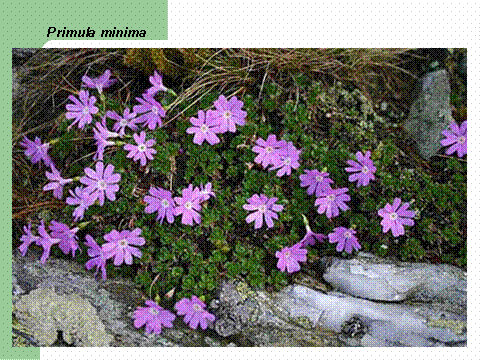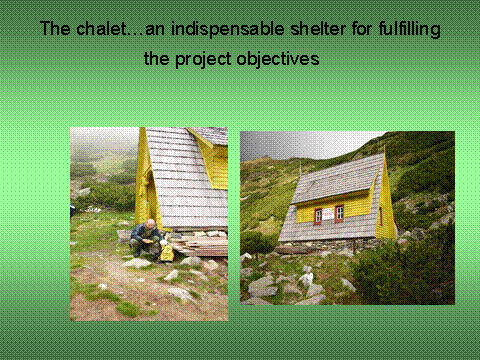TECHNICAL PROGRESS REPORT 2004 YEAR
1. Introduction
The 2004 was the first year of the project that initially was planned to start on 01 June 2003 and to be finished on 01 June 2007 , i. e. 48 months duration. Because of well known reasons, the work could not be start earlier than January 2004. However, the termination will takes place in due course.
2. Project objectives
- Restoration of P. cembra / P. mugo / Picea abies natural habitat on 50 ha from Zanoaga hollow of the Pietrosul Rodnei Biosphere Reserve. The area is shared, such as: P.cembra 25 ha and P. abies 25 ha; the P. mugo bushes will be planted at irregular distances among the trees of the other two species, i. e. it shares the same surface.
- Conservation of all flora and fauna habitats on 6 415 ha including P. cembra / P. mugo / Picea / abies one from the Pietrosul Rodnei Biosphere Reserve
3. Expected results
On immediate term :
- Restoration of P. cembra / P.mugo / P. abies habitats on 50 ha
On medium term:
- Creation of better conditions of life for herbaceous flora and wildlife followed by a normal future development;
- Preventing soil erosion and flooding;
On long term:
- Creation of normal conditions for natural regeneration of the P. cembra / P.mugo / P. abies habitats. Then, from Zanoaganucleus, these habitats extend little by little to the surrounding areas.
- Preventing avalanche formation
- Implemented long-term conservation management plan of all flora and fauna habitats on 6 415 ha of the Pietrosul Rodnei Biosphere Reserve. Owing to the sustainable conservation management, positive evolution of restoration process will be achieved.
4 . Details concerning fulfiled deliverable products on 2004
4.1 Action A.1 : Assessment of the woody, herbaceous and rocky ecosystems / habitats from Pietrosul Rodnei Biosphere Reserve based on both GIS high-resolution satellite imagery and field survey.
This a ction consisted of the following foreseen sub-actions:
4.1.1 GIS distribution map of the flora and rocky ecosystems / habitats, including P. cembra / P.mugo / P. abies ones, on 6415 ha from the Pietrosul Rodnei Biosphere Reserve.
4.1.2 Scientific inventory of herbaceous species on 6 415 ha from the Pietrosul Rodnei Biosphere Reserve.
6.1.3 Scientific inventory of bird and mammals habitats on 6415 ha from the Pietrosul Rodnei Biosphere Reserve.
4.1.1 Digital distribution map (geographic data base) of the flora and rocky ecosystems / habitats, including P. cembra / P.mugo / P. abies ones, on 6415 ha of the Pietrosul Rodnei Biosphere Reserve
The objective of this action was to compile distribution map of the flora habitats with its associated geographic components. The GIS and remote sensing team that belongs to the Forest Research and Management Institute did this work. The digital map is based on Quick Bird imagery with spatial resolution at 0.6 m of the panchromatic band and 2.4 m multispectral.
The image was georefernced based on existing printed (1:5,000 scale) topographic maps. From these maps were collected (vectorised) contour lines and ground control points (GSP). Based on contour lines the digital elevation model (DEM) was build. Using DEM and GSP the ortho-rectification was done using QuicBird specific mathematical model within ERDAS Imagine software.
To take the advantages of both spectral information (including near infrared, very useful for vegetation studies) and highest spatial resolution of panchromatic band a fusion of these components was performed. For detailed studies, the result was displayed as color infrared image (false color composite). Where the vegetation appears in red hues, this way of displaying, allows more details detection within vegetation cover. A version of "real" colors (vegetation appears in green hues) was displayed and printed as spatial map, to be more familiar of the public.
The resulted spatial map shows the woody and herbaceous and rocky ecosystems / habitats. Due to its very high spatial resolution, the maps allow to be seen not only ecosystems but the planted seedling beds of 80 x 80 cm size, too.
The next operation was a field check of the visual image interpretation and georeference accuracy evaluation. This task was done using a Trimble PathFinder GPS. The accuracy evaluation shows the target of 1:5,000 scale accuracy was achieved.
Final operation was the on-the-screen vectorisaton of the main limits of the flora and rocky ecosystems / habitats and encoding of each type of land cover. The result is a land cover stratum as shape file (ArcView) containing accurate geographic information that could be up-dated and combined with others geographic information, usable to build different maps and for spatial analyze.
It should be stressed that this map, which will be insert on our webpage, represents a premiere for the Pietrosul Rodnei Biosphere Reserve and for any other similar unit from Romania .

4.1.2 Scientific inventory of herbaceous species on 6 415 ha of the Pietrosul Rodnei Biosphere Reserve
A comprehehensive inventory of the herbaceous species was made and, by the middle of February 2005, it will be included in the Project webpage. This inventory shows that the respective Biosphare Reserve is extremly rich in herbaceous species, and the following botanical characteristics are highlighted here:
a number of 58 families with 568 herbaceous species have been living on 6 415 ha of the Pietrosul Rodnei Biosphere Reserve;
the Asteraceae and Poaceae families with 98 and 54 species, respectively, were the richest ones, while a number of 13 families have only one species, each one;
most of the families / species were recorded on alpine and sub-alpine pasturelands but the herbaceous flora found under the forest conopy was, as normal, poorer mainly in conifers..
|
|
4.1.3 Scientific inventory of bird and mammal habitats on 6415 ha from the Pietrosul Rodnei Biosphere Reserve.
A very detailed inventory of the birds was made by a specialist in ornithology from outside of our Institute. Because the Institute has no an ornithologist, this work was sub-contracted The following details are presented in the bird's inventory:
The birds of the Biosphere Reserve were distributed in nine orders, 28 families, 58 genera and 86 species;
With its 18 families and 53 species, the Passeriformes order is the biggest while the Cuculiformes order with only one family and one species, is the smallest one;
The Turdidae family with its 10 species is placed in the top of the rank;
Of 86 bird species, 87 % are nesting within the Biosphere Reserve while 13 % are passengers;
Again, of 86 bird species, 10 are present on the Romanian Red List, while only one ( Aquila clanga ) can be found on the European one.
The species were classified according to their origin, ecology, frequency and phenology.
The Mammals inventory has the following composition:
Forty one species distributed in six orders and 17 families;
According to the Romanian low 462 / 2001, six species require strict protection and they are included in the Red List, such as: Canis lupus, Lynx lynx, Neomys anomalus, Sicista betulina, Sorex alpinus and Ursus arctos ;
Of the European Red List, the following species are living in the Biosphere Reserve, as follows: Lynx lynx, Ursus arctos Canis lupus, Felis silvestris.
In the past until recently, the illegal hunting caused serious damages in wildlife. Also, the shepherds and local people and the tourists used to collect wild flowers and together with the domestic animal grazing they represented a destructive factor to the flora and fauna. It should be stressed that the factors contributing to the degradation of flora and fauna, mainly wildlife, significantly decreased in favor of restoration. This is because since early 2004, the Pietrosul Rodnei Biosphere Reserve was included within the National Park of the Rodnei Mountains which is administrated by the Romsilva National Forest State Administration . This National Park was provided with a staff, including three rangers, who take care of the whole area, including Pietrosul Rodnei Biosphere Reserve . Owing to this situation, the Project team did consider that it is not necessary to hire another parallel staf of rangers.
4.1.4 Purchasing durable goods fom Action A.1
The following durable goods were purchased: GIS soft upgrading, h hardware upgrading and a digital camera and Quik Bird satellite imagery. These durable goods are currently used for implementation of the project specific actions.
Total allocated for Action A.1 21 670 E
Spent from the EC budget 13 035 E
4.2 Action A.2: Preparation of the technical management plan aiming at P. cembra species re-introduction and P. cembra / P.mugo /
P. abies habitat restoration.
A technical management plan was conceived, comprising step by step all activities aiming at P. cembra species re-introduction and P. cembra / P.mugo / P. abies habitat restoration on 50 ha This plan was made and already applied as a guide during the year 2004 season in order to ensure the success of Pinus cembra and Picea abies re-introduction by plantig as specified with the Action C.1. This project comprises all actives connected with the objective to be reached, such as: techniques for planting stock production, including seed origin, seed collection and processing, nursery techniques, planting technique, etc and all concerned costs.
Total allocated . 1 190 E
Spent from the EC budget.....897 E
4.3 Action C.2: Construction of refugee chalet and a toilet
In order to sheltering scientists and technicians and workers during the project implementation, a refugee chalet was built near the planting area.. Initially, a one room chalet was planned but finally a two rooms chalet including an attic was built. The conifer wood was used as basic material for construction of all components such as: infrastructure, walls, roof of shingle, doors and windows. For a better protection against harsh climatic conditions, the external walls of the refugee chalet were painted using a yellowish oil paint. For the same reason, the roof was painted with a two layers mineral oil of dark colour. The inside refugee chalet was equipped with superposed beds and other stict necessary equipment. Alltogether, 16 persons can be accomodated in the two rooms and the attic. It should be stressed that because of a continuous stony underground layer it was not yet possible to built a permanent toilet. Looking for a better site, but at a longer distance from the chalet, a permanent toilet will be built next year. However, temporary toilet was arranged to be used until the new one will be made.
It should be mentioned by far the currency foreseen in the Project for this action was sub-evaluated and for this reason, the Forest Administration of the Maramures County (located in the Baia Mare Town) contributed free of charge with woody materials and other things.
Total allocated 4 480 E
Spent from the EC budget.............0 E
Baia Mare co-financing 4 033 E
|
Photo: The chalet placed near the planting area was used for workers, and qualified personnel for accommodation during the field activities, such as: land picketing, site preparation, plantation periods, rangers accommodation, etc. On the left side picture, our specialist in GIS is taking the local geographic coordinates.
4.4 Action E.4 Video documentaries and media presentations
This action consists of two sub-actions, as follows:
- To purchase a video camera;
-To film the results of the major project actions and finally to present two documentary films to the project meetings and to other national and international workshops. Also, these films will be used for public awareness regarding the LIFE project actions and the acquired results. These aspects provide a clear overview to all factors that may be concerned, such as: members of Advisory Board, Management Team, local stakeholders, as well as national and international authorities for a better overview of the area and actions developed under the LIFE project.
It should be stressed that by now, only the first sub-action was solved so that a video camera; was purchased which will be used for the first documentary film preparation.
Total allocated ... 4 120 E
Spent from the EC budget 1 764 E
4.5 General picture of deliverable products on 2004
(Blue: fulfiled actions in 2004)
(Red: delayed actions to 2005)
Product |
Name or n° of reference action |
Deadline |
GIS distribution map of the flora and rocky ecosystems / habitats, including P. cembra / P.mugo / P. abies ones, from Pietrosul Rodnei Biosphere Reserve (6415 ha) |
A.1 |
February 2004 |
Scientific inventory of tree and shrub woody species / habitats from Pietrosul Rodnei Biosphere Reserve (6 415 ha); |
A.1 |
July 2004 |
Scientific draft concerning distribution and structure of the P. cembra / P.mugo / P. abies habitat in Pietrosul Rodnei Biosphere Reserve (6 415 ha); |
A.1 |
December 2004 |
Scientific inventory of herbaceous species / habitats from Pietrosul Rodnei Biosphere Reserve (6 415 ha);
|
A.1 |
October 2005 |
Scientific inventory of bird and mammals habitats from Pietrosul Rodnei Biosphere Reserve (6 415 ha);
|
A.1 |
October 2006 |
Technical management plan comprising step by step all activities aiming at P. cembra species re-introduction and P. cembra / P.mugo / P. abies habitat restoration on 50 ha
|
A.2 |
December 2003 |
Long-term Conservation Management Plan to enforce sustainable activities of all flora and fauna habitats on 6 415 ha from Pietrosul Rodnei Biosphere Reserve
|
A.3 |
January 2004 |
Refugee chalet and toilet cabin
|
C.2 |
September 2003 |
A draft showing the evolutionary process of P. cembra species re-introduction and of P. cembra / P. mugo / P. abies habitat restoration on 50 ha at the end of the project
|
D.2 |
May 2007 |
Project Website |
E.1 |
October 2004 |
4 000 printed brochures and 2 000 leaflets
|
E.2 |
April 2006 |
Layman's report |
E.2 |
July 2006 |
First video documentary film
|
E.4 |
July 2005 |
Second video documentary film
|
E.4 |
June 2006 |
First Technical Progress Report |
F.1 |
December 2004 |
Second Technical Progress Report |
F.1 |
December 2005 |
Third Technical Progress Report |
F.1 |
December 2006 |
Final Technical Report and independent audit report |
F.1
|
June 2007 |
ACTIVITY REPORTS FORESEEN
(Progress Report, Interim Report, Final Report)
First Progress Report |
December 2004 |
Second Progress Report |
December 2005 |
Third Progress Report |
December 2006 |
Final Report |
June 2007 |
|
|
5. Details concerning fulfiled project milestones
5.1 Action A 4: Set up the Advisory Board and Management Project Team
To ensure the correct implementation of the project, on January 2004, the A dvisory Board and Management Project Team were set up.
The Advisory Board consists of 17 members and includes representatives of the local authorities of the economic and cultural institutions, land owners, forest administrators, fisher men and hunters and the Forest Research Institute representatives,as well. The main task of this Advisory Board board is to ensure the project implementation, acting as a working framework. In this year, the board has had two annual meetings where the project manager, presented the acheved results.
The Management Project Team consists of 16 members and it is composed of scientists whom background is connected with the scope of the project. The status of the project implementation will be reported to the Advisory Board.
Total allocated . 750 E
Spent from the EC budget .857 E
5.2 Action C.1: Effective re-introduction of P. cembra and restoration of P. cembra / P.mugo / P. abies habitat by planting in the Zanoaga hollow from the Pietrosul Rodnei Biosphere Reserve
The following sub-actions or b asic operation aiming to re-introduce P. cembra and to restore P. cembra / P mugo / P. abies habitats were fulfiled:
2004
5.2.1 Sticks preparation
A number of 5000 conifer wood sticks were prepared to be used for land picketing. The stick dimensions were 100 cm long, 5 cm wide and 3 cm thick.
5.2.2 Land marking / picketing
This was the first field operation aiming at marking the place where the seedling bed has to be hoed . To be visible from distance, in the spring of the year 2004, each of the 5000 seedling beds (for Pinus cembra and Picea abies species) covering 50 ha were marked by the prepared sticks. The sticks helped the worker to find out the place where the seedling bed has to be prepared.

5.2.3 Seedling bed or site preparation (May / June 2004)
The operation of hoeing of the seedling bed took place, immediately after the land picketing, i. e. during the spring of the year 2004. The seedling bed dimentions were of 80 cm x 80 cm a 20 cm depth. Because of the extremely harsh environment conditions (compact and/or lack of soil, dense Vaccinium sp. and herbaceous layer, stony ground, presence of bushes, etc.), this operation was made by the mountain special hoe. According to the site conditions, two kinds of tools were used, such as: the hoe when the soil was rockless and crowbar when the seedling bed substratum consisted more of stones than soil. By this way, a total of 5000 seedling beds were prepared.

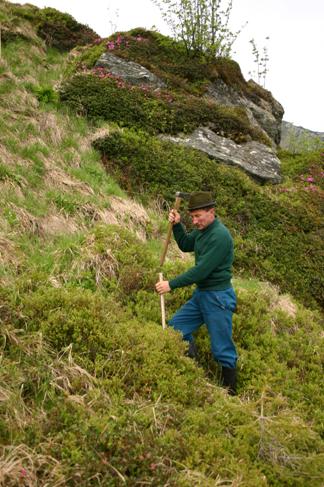
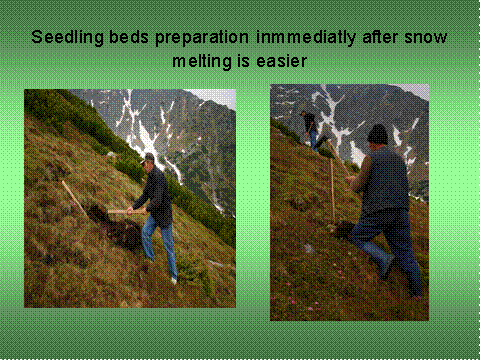

Photo: The lower side of the area with its prepared seedling beds
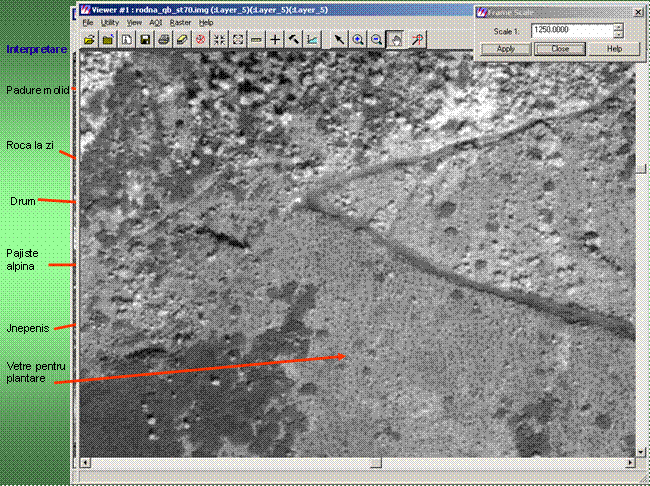
GIS satellite Photo: The seedling beds preparation was finished at the beginning of July; this picture represents sample of the work area with its seedling beds that can be seen from the satellite (Quik Bird Imagery from July 10, 2004 )
Seedling origin and supply
The P. cembra reintroduction and restoration of P. cembra / P.mugo / P. abies habitat s was conceived to be done according to the genetic and ecological requirements. For this reason, P. cembra seedlings originate in the natural population of the Ineu Mountain , a neighbour of the Pietrosul Mountain . Therefore, the population from Ineu Mt. have the same genetic base and ecological requirements as that from Pietrosul Mt. where project area is placed. Prior to launched the Proect, these seedlings were already produced in the Sinaia Nursery belonging to the Bucharest Forest Research and Management Institute. The seedlings were grown in individual big plastic bags fill in with acidophilous spruce humus and at the planting moment some of them were seven to nine years old. Each seedling + plastic bag weights between 5-6 kg. Such material ensures the planting success.
Picea abies seedlings have their origin in a natural population from Pietrosul Rodnei Mountain , i. e. very close to the project area. This material was also grown in big plastic bags at the Sinaia Nursery.

PHOTO: On the left side picture one can noticed part of the Pinus mugo seedlings to be planted next year; they can be recognise because of their greener colour than that of Pinus cembra (picture from right hand side
2.5 Seedling transportation
The seedling transportation proved to be a very difficult task because:
the seedlings were grown in plastic pots fill in with soil and for this reason, they could not be overlap during transportation;
at 600 m elevation, the Sinaia Nursery is placed in a hollow and because of this, the seedling transportation to the accessible road to the lorry had to be made by a cart pulled by a horse for about 1 km at 750 m elevation;
then the seedlings were loaded in two big lorries with their trailers and transported about 650 km to the Borsa Town down town;
then the seedlings were transffered on four powerful lorries and transported seven km to the Borsa outskirts placed at 700 m elevation where the seedlings were unloaded;
then the seedlings were transported to the mountain planting site at about 1800 m elevation; on a very bad slopy pritive road, a caterpillar tractor was used (See photo). Eight days were necessary for seedlings transportation from Borsa outskirts intermediate deposit to the Pietrosul Mt.
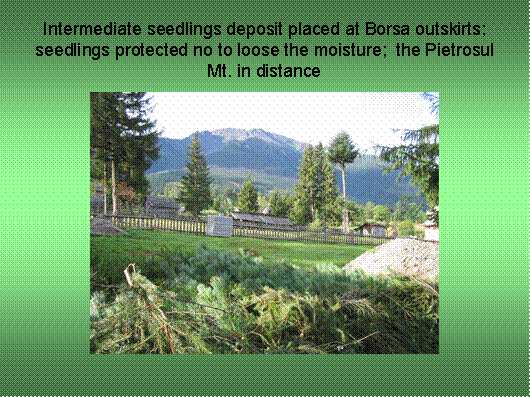

5.2.6 Planting operation including its associated preparations (August / September 2004)
5.2.6.1 Seedlings distribution to the seedling beds
By using wood baskets, the 5000 potted seedlings were carried by the workers (on their back) to the planting bed / hole distributed all over 50 hectares. Because of the seedling + soil weight and slopy land and wilde vegetation, this work was very hard and difficult.

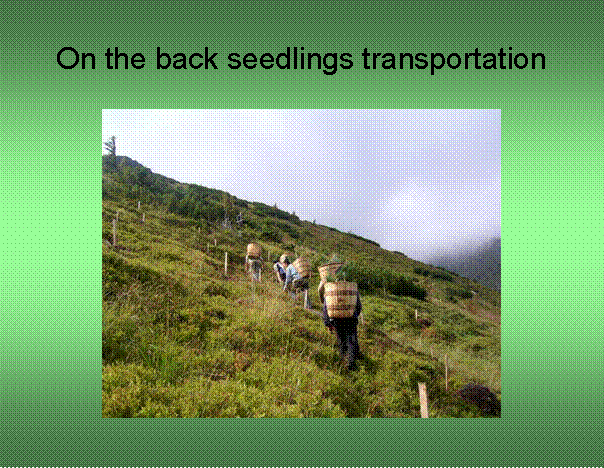

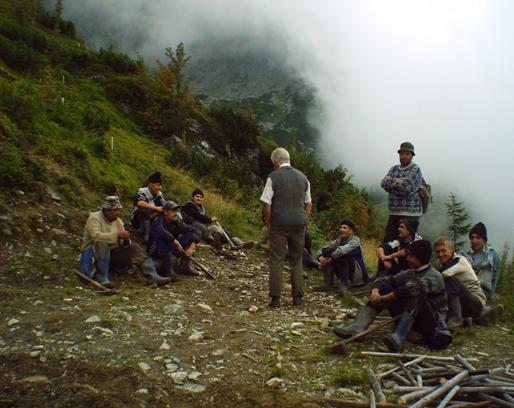
Photo: rest after a hard working day
5.2.6.2 Transporting borrowed soil
On some parts of the planting area, about 1000 seed bed required borrowed soil. This soil was transported by the carterpillar tractor from lower elevation outside Biosphere Reserve, at about 800 m elevation, to about 1700 m elevation where it was deposited. From that place, using wood baskets, the workers carried the soil on their back to the soilless seedling beds. Because of the soil weight, and slopy land and wilde vegetation, this work was a very hard one.
5.2.6.3 Plantation
5.2.6.3.1 Project task for Action C.1
To reintroduce to restore P. cembra / P.mugo / P. abies habitat s by their planting on 50 hectares; this area was planned to be planted in the years 2004, 2005 and 2006, consecutively;
Seedlings per species: 2500 P. cembra, 2500 P. abies and 5000 P.mugo;
Hectares per species: 25 for P. cembra and 25 for P. abies. Because the reasons presented below, the P.mugo isl not taken into account in area calculation.
Planting design: because an ecological plantation is assumed to be made, a 10 x 10 m average distance was taken into account. But, in any case a regular planting framework will be avoided. It is well known that P. cembra and P. abies trees are "tall" while the P. mugo has horizontal bush form trees. For that reason, the 5000 P. mugo seedlings will be planted (over the same 50 hectares), at irregular distance, among the other two tree species. In other words, it was not taken into account at the area calculation.
The area in question is located in the Pietrosul Rodnei Mountain , namely in Zanoaga Hollow and its surroundings.
5.2.6.3.2 Planting
In August / September 2004, 50 hectares were planted with 5000 seedlings of P. cembra and P. abies . Each species participated with 2500 seedlings. Each seedling was planted, in the center of the seedling bed, in a hole of 30 x 30 cm deep
The plantation took place in Zanoaga Hollow and its neighbourhoods ranging between 1600-1990 m elevations within the Pietrosul Rodnei Biosphere Reserve. The reason of this planting in advance, more than foreseen, was that the project beneficiary possessed well developed all previously mentioned seedlings. In addition this fact guarantees that the major action (C1) of the Project will be fulfilled in due course.
In the years 2005 and 2006, the 5000 P. mugo seedlins will be planted among the seedlings of the other two species, so that they occupy the same 50 hectares area.
Total allocated for the C.1.. 97 210 E
Spen from the EC budget .4 435 E
ICAS co-financing .. 29 699 E (seedlings cost)
FSAM co-financing . 16 574 E (man-power for plantation, etc.)
Total co-financing 46 273 E

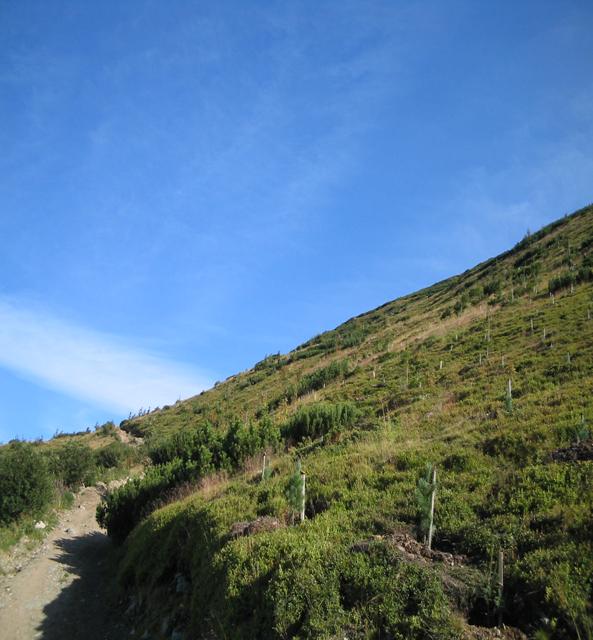
Photo: sample of the lower side of the planted area

5.3 Action C.3: Information panels, construction and their installation
Ten information panels, five in Romanian and five in English, were made on plastic material. The panel text (See the enclosed photos) , written electronically using the Corel Program, comprises European Community recmmendations, such as:
the LIFE logo and partners logos placed in front of the panel;
the project objectives;
the project major actions;
a specific recommendation to the public to protect the planted trees and all flora and fauna species from the whole Biosphere Reserve.
The panels were installed in strategic places accessible and visible to the public
With regard to the way the pannels were installed, it should be stressed that a Romanian together with an English version of the panel were placed on the same 1 m tall x 1 m wide board, i. e. one version was inserted on the back of the other. Each board was equiped with a roof in its upper side while in the lower side with two fee (See the below photo).
Because the allocated amount for this Action was not entierly spent, some other panels could be order in the 2005 year.
Total allocated 2020 E
Spent from the EC budget ..0.E
FSAM co-financing 1642 E
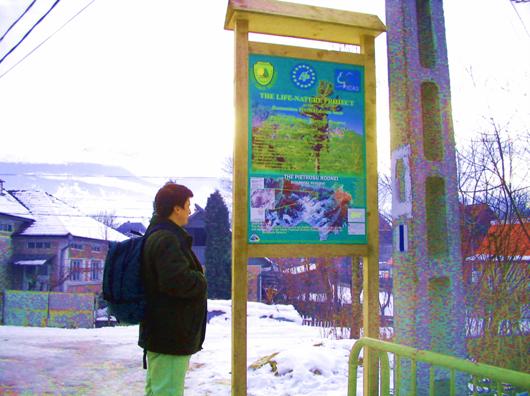
5.4 Action E.3: First l ocal workshop and stakeholder consultation meeting
On October 1, 2004 , in the Borsa Town , took place the project first workshop with the following schedule:
- Presentation of the Project solved actions (I. Blada and A. Filip);
- Presentation of the Rodnei Mountains National Park: images and figures (D. Jauca and I. Muntean).
- S takeholder consultation meeting.
- Visiting the 50 hectares planted area with P. cembra and P. abies in the Zanoaga Hollow from the Pietrosul Rodnei Mountain.
The first two items were presented on Power Point in the Borsa M ayorhause. The 37 participants to the workshop appreciated very much the results of the Action C.1, e.g. the fact that 50 ha degraded habitats, placed on difficult geographic conditions, and were planted. In a very sunny afternoon, after indoor meeting, the younger participants climbed the mountain and visited the planted area where the encountered problems were presented.
Before departure to the planted area, the stakeholder consultation meeting was held in the same building. Discussions from that meeting were focussed on current problems that are facing not only the project but also the whole National Park. It was mentioned the welcomed financial of the European Community and of the two co-financers.
The high interest of the participants in supporting the project actions was the main conclusion of that workshop.
NOTE
Since early January 2005, the LIFE Nature Pietrosul project has its own web page on internet ( www.icassv.ro/life_pietrosu ) where the power point presentation at the first workshop (held on October 1, 2004 ) will be soon insert.
Total allocated . 5 540 E
Spent from the EC budget .2 658 E

Photo: With one exception, only young delegates to the first workshop did climbed to the planted area
5.5 Action F.2: Workstation Development
In the frame of this action, the following durable goods were purchased: two desktop PC a laptop, and a printer. The laptop was purchased instead of a desktop. This laptop helps the working team in order to be used when outside the Institute. The three computers proved to be very useful for office everyday activities and project database establishment. The flipchart and slide and overheads projectors were not purchased as they are of no too much use as the presentations can be easier done on power point which was already used during the first workshop.
Total allocated 5 720 E
Spent from the EC budget . 4 783 E
Financial summary for the year 2004
(1) Total allocated in the Project.. . .213 470 E
(2) Total received advance from EU.... . 42 694 E
(3) Total spent from the EU budget .. ... 27 340 E
(4) Total ICAS co-financing .............. 27 704 E
(5) Total FSAM Baia Mare co-financing ..22 249 E
(7) Total co-financing (3) + (4) ... 77 293 E
(8) Total credit balance in the account 15 354 E)
(42 694 E - 27 340 E = 15 354 E)
NOTE 1:
In the year 2002 when the LIFE Project was prepared, three rangers were foreseen at the Action D.1 to be hired. Afterwards, the Romsilva National Administration of the Forests created the Rodnei Mountains National Park where three rangers paid by the Romanian Government,
were hired. Because that park entirely included the Pietrosul Rodnei Biosphere Reserve i t was un-necessary to hire other rangers. So that the LIFE project will not financially support any ranger.
NOTE 2:
Again, in the year 2002 when the LIFE Project was prepared the Romanian legislation did allow to any state enterprises, including our partner from Baia Mare, to solve any work with their own Personnel. In the meantime the regulations were changed in the sense that any kind of work must be made using specialized private companies elected by competition among three candidates companies. The SC IURES COM SRL COMPANY located in Bistrita did earn the competition to make all our work from the following actions:
C1: Effective reintroduction of P. cembra and restoration P. cembra / P. mugo / Picea abies habitat by planting;
C2: Construction of a small size refugee chalet and toilet;
C3: Information panels construction and their installation
This the reason why the Forest State Administration of the Maramures County, located in Baia Mare, could not include their co-funding amount (17847 Euro) to the Personnel where initially the currency was foreseen, so that, all these expenses were placed to External assistance .
Conclusions
- As the approved project arrived late autumn of the year 2003, the work started in January 2004;
- The four actions foreseen for the 2003 year were fulfilled in 2004;
- Four out of six actions foreseen for 2004 were solved while two of them were postponed to 2005; the Project webpage, one of the postponed actions, were already solved in January 2005, so that anybody can visited it at: www.icassv.ro/life_pietrosu ;
- In addition, four and two actions from the years 2005 and 2006, respectively were solved in 2004;
- According to the Project Manager opinion, the Action C1 is one of the most difficult tasks to be fulfilled. Twenty hectares were planned to be planted in 2004, but, because the ICAS had already in the nursery the Pinus cembra and Picea abies seedlings, 50 hectares were planted with these two species. The 5000 Pinus mugo seedlings will be planted, in 2005 and 2006, between the first mentioned two species, covering the same 50 ha area. It should be stressed that serious difficulties were encountered during fulfilling all sub-actions of the Action C1. In addition, a significant trouble took place, i. e. the caterpillar tractor had thrown on slope but fortunately, nobody was killed. However, the tractor was broken;
- The cooperation with the county Forest Administration and with the external contracted Company that executed the field works was remarkable; otherwise planting could not take place;
- Local authorities, stakeholders, scientists, foresters, teachers greatly appreciated restoration of the Pietrosul habitats restoration through EC contribution;
- Regarding to the financial aspect, in the year 2004, each contributor to the Project supported the following amounts: EC 28589 Euro, ICAS 29699 Euro and FSAM 22249 Euro.
- The project team invite the EC authorities to visit the the implemented on the field the LIFE Nature Project.
5.6 SUMMARY OF PROJECT MILESTONES fulfiled in 2004
(Blue: fulfiled actions in 2004)
(Red:: not fulfiled in 2004 and delayed for 2005)
Milestone |
Name or n° of reference action |
Deadline |
Set up the Advisory Board and Management Project Team .
|
A.4 |
September 2003 |
Effective re-introduction by planting P. cembra species and restoration of P. cembra / P.mugo / P. abies habitat on 20 ha (remainder 30 ha) in the Zanoaga hollow from the Pietrosul Rodnei Biosphere Reserve (Part one).
|
C.1
|
October 2004 |
Effective re-introduction by planting P. cembra species and restoration of P. cembra / P.mugo / P. abies habitat on 20 ha (remainder 10 ha) in the Zanoaga hollow from the Pietrosul Rodnei Biosphere Reserve (Part two) |
C.1
|
October 2005 |
Effective re-introduction by planting P. cembra species and restoration of P. cembra / P.mugo / P. abies habitat on 10 ha (to get 50 ha as planned) in the Zanoaga hollow from the Pietrosul Rodnei Biosphere Reserve (Part three) |
C.1
|
October 2006 |
10 information panels planted in key places |
C.3 |
July 2004 |
Implementation of Long-term Conservation Management Plan by integrating the best measures for conservation of all flora and fauna habitats on 6 415 ha from the Pietrosul Rodnei Biosphere Reserve |
D.1 |
April 2006 |
First Local Workshop followed by an excursion to the project area.
|
E.3 |
June 2004 |
Second Local Workshop followed by an excursion to the project area.
|
E.3 |
June 2005 |
Third Local Workshop followed by an excursion to the project area. |
E.3 |
May 2007 |
Workstation Development |
F.2 |
December 2003 |
TECHNICAL REPORT 2005 YEAR
1. DETAILS CONCERNING FULFILED THE PROJECT DELIVERABLE PRODUCTS ON 2005
Action A.1
1.1 Scientific inventory of tree and shrub woody species from Pietrosul Rodnei Biosphere Reserve
According to the working plan, a full inventory of the tree, shrub and sub-shrub species was done. Comparing to the herbaceous species inventory, the woody species one is much poorer. The woody inventory of the Pietrosul Rodnei Biosphere Reserve comprises 49 species of which, 15 tree, 23 shrub and 11
Among the forest tree species, Picea abies, Fagus sylvatica and Alnus incana are the most spread in the area. The Pinus cembra was represented only by scattered trees while Pinus mugo was the most spread over the explored area. For more details, see the enclosed inventory.
1.2 Scientific draft concerning distribution and structure of the P. cembra / P.mugo / P. abies habitat in Pietrosul Rodnei Biosphere Reserve
In order to get details about the distribution and structure of the woody species habitats, during the vegetation season of the 2005 year a comprehensive survey al over the Pietrosul Rodnei Biosphere Reserve was done. The survey focused on each of the three altitudinal levels of vegetation currently recognized, such as:
- mountainous level with two sub-levels
average sub-level between 740 and 1100 m elevation;
high mountainous sub-level between 1100-1500 m elevation;
- sub-alpine level between 1500 and 1900 m elevation;
- alpine level between 1900 and 2003 m elevation.
The mountainous level with its average sub-level between is characterized by the occurrence of the beech ( Fagus sylvatica ) and spruce ( Picea abies ) forests where Acer pseudoplatanus, Sorbus aucuparia and Betula pendula scattered tees can vegetate.
The sub-alpine level is characterized by the occurrence of the scattered or in groups, the following woody species: Pinus cembra, Juniperus sibirica and Rhodendron myrtifolium.
In its composition, the alpine level has small trees or bushes of Salix reticulate and Vaccinium gaultherioides.
It should be stressed that survey took into account not only woody vegetation but all environmental conditions in which it develops, such as: geology, geomorphology, hydrographic factors, soil,
For the Action A.1, a total of 2306 Euro was paid in the year 2004, from the External Assistance. The following items were covered with that amount:
Scientific inventory of herbaceous species / habitats from Pietrosul Rodnei Biosphere Reserve ( 6 415 ha );
Scientific inventory of bird and mammals habitats from Pietrosul Rodnei Biosphere Reserve ( 6 415 ha );
Scientific inventory of tree and shrub woody species / habitats from Pietrosul Rodnei Biosphere Reserve (6 415 ha);
Scientific draft concerning distribution and structure of the
P. cembra / P.mugo / P. abies habitat in Pietrosul Rodnei Biosphere Reserve (6 415 ha);
Therefore, the cost of the last two sub-action (A.1 and A.1 continued) presented above in this report, were paid last year, together with the first two sub-actions, through the same external assistance contract.
Action E.1
1.3 Project website
On behalf of the LIFE Project, on January 2005, a website was opened on the internet, at the address: www.icassv.ro/life_pietrosu where the structure of the Project was already uploaded. But, from the January 2006 onwards all solved actions in the years 2004 / 2005 can be visited.
Total allocated 480 E
Total spent 265 E
Action E.4
1.4 Video documentaries and media presentations
In the 2005 year, the first documentary film was foreseen to be made in the frame of this Action. It should be stress that all the images were recorded and they are ready to be inserting on a roll of film and install the sonor. Nobody from the Project team is able to do that. Three operators specialists in film were contacted by now but because of the small amount of currency foreseen (800 Euro at External Assistance), no one accepted to prepare our film. This business remains opened and, hopefully, the problem will be solved next year. However, some of the recorded pictures were used in our Power Point presentations for public awareness.
From the Table 1.4 one can see that:
- the most difficult actions were solved, such as, GIS distribution map, woody, herbaceous and birds inventories and refugee chalet;
- all but two actions were solved;
1.4 General picture of deliverable products fulfilled between January 1, 2004 and November 30, 2005
(Blue: fulfilled actions in 2004 and 2005)
(Red: two actions delayed to 2006)
Product |
Action |
Deadline |
GIS distribution map of the flora and rocky ecosystems / habitats, including P. cembra / P.mugo / P. abies ones, from Pietrosul Rodnei Biosphere Reserve ( 6415 ha ) |
A.1 |
February 2004 |
Scientific inventory of tree and shrub woody species / habitats from Pietrosul Rodnei Biosphere Reserve ( 6 415 ha ); |
A.1 |
July 2004 |
Scientific draft concerning distribution and structure of the P. cembra / P.mugo / P. abies habitat in Pietrosul Rodnei Biosphere Reserve ( 6 415 ha ); |
A.1 |
December 2004 |
Scientific inventory of herbaceous species / habitats from Pietrosul Rodnei Biosphere Reserve ( 6 415 ha ); |
A.1 |
October 2005 |
Scientific inventory of bird and mammals habitats from Pietrosul Rodnei Biosphere Reserve ( 6 415 ha ); |
A.1 |
October 2006 |
Technical management plan comprising step by step all activities aiming at P. cembra species re-introduction and P. cembra / P.mugo / P. abies habitat restoration on 50 ha
|
A.2 |
December 2003 |
Long-term Conservation Management Plan to enforce sustainable activities of all flora and fauna habitats on 6 415 ha from Pietrosul Rodnei Biosphere Reserve |
A.3 |
January 2004 |
Refugee chalet and toilet cabin
|
C.2 |
September 2003 |
A draft showing the evolutionary process of P. cembra species re-introduction and of P. cembra / P. mugo / P. abies habitat restoration on 50 ha at the end of the project |
D.2 |
May 2007 |
Project Website |
E.1 |
October 2004 |
4 000 printed brochures and 2 000 leaflets |
E.2 |
April 2006 |
Layman's report |
E.2 |
July 2006 |
First video documentary film |
E.4 |
July 2005 |
Second video documentary film |
E.4 |
June 2006 |
First Technical Progress Report |
F.1 |
December 2004 |
Second Technical Interim Report |
F.1 |
December 2005 |
Third Technical Progress Report |
F.1 |
December 2006 |
Final Technical Report and independent audit report |
F.1
|
June 2007 |
ACTIVITY REPORTS FORESEEN
(Progress Report, Interim Report, Final Report)
First Progress Report |
December 2004 |
Technical Interim Report |
December 2005 |
Third Progress Report |
December 2006 |
Final Report |
June 2007 |
|
|
2. DETAILS CONCERNING FULFILED PROJECT MILESTONES
Action C.1
2.1 Effective re-introduction by planting P. cembra species and restoration o P. cembra / P.mugo / P. abies habitat on 10 ha (to get 50 ha as planned) in the Zanoaga hollow from the Pietrosul Rodnei Biosphere Reserve
2.1.1 Sticks preparation
A number of 1700 conifer wood sticks were prepared to be used for land picketing. The stick dimensions were 100 cm long, 5 cm wide and 3 cm thick. All the sticks were transported to the Pietrosul Mt. by a caterpillar tractor.
2.1.2 Land marking / picketing
This was the first field operation aiming at marking the place where the seedling bed had to be hoed . To be visible from distance, in the spring of the year 2005, each of the 1700 seedling beds (for Pinus mugo species) were marked by sticks. The sticks helped the worker to find out the place where the seedling bed has to be prepared.
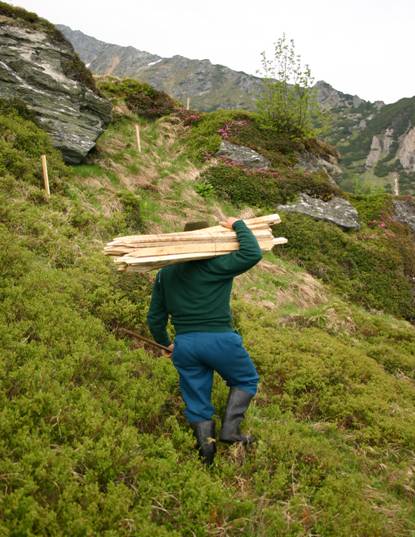
Picture 1 Sticks transportation

Picture 2. The place of a future seedling bed was marked

Picture 3. The land picketing was finished
2.1.3 Seedling bed or site preparation
Effective site preparation took place at the end of June 2005 while the plantation in the autumn of the same year.
Operation consists of digging / hoeing each seedling bed (by the mountain special hoe) at 20 cm depth. Because of extremely harsh environment conditions (compact and/or lack of soil, dense Vaccinium sp. and herbaceous layer, stony ground, presence of bushes, etc.), planting seedlings is not possible without a previously site preparation like this one.
According to the site conditions, two kinds of tools were used: hoe, when the soil is rock less and crowbar when the seedling bed consists more of stones than soil.
The operation of hoeing of the seedling bed took place, immediately after snow melting and land picketing. The seedling bed dimensions were of 80 cm x 80 cm and 20 cm depth. By this way, a total of 1700 seedling beds were prepared.
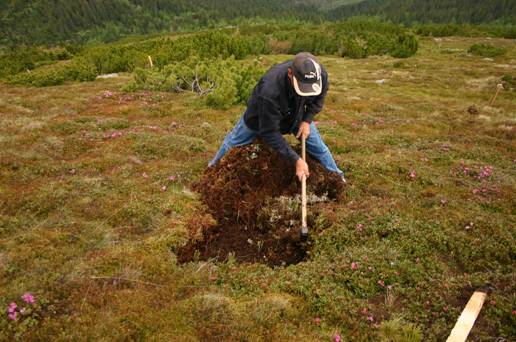
Picture 4. After the snow melting, the seedling bed preparation is easier than during the autumn

Picture The seedling bed is ready
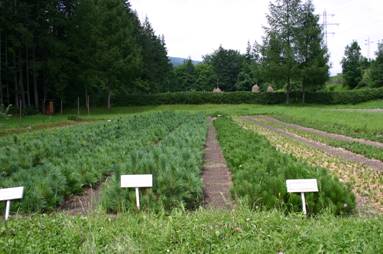
Picture 6. The Sinaia Nursery (ICAS owner) and P. cembra (left hand side) and P. mugo (right hand side) where the seedlings were grown
2.1.5 Seedling transportation
As specified in the Project, the seedlings have been producing by the Beneficiary / partner (ICAS) and the cost of the seedlings represents most of the Beneficiary's co financing.
Because the nursery is placed down in a hole, the seedlings in plastic bags had to be manually transported (See the picture), at about 300 m distance, to the access lorry road and then loaded on the lorry. Then the seedlings were transported, about 700 km away, from the Sinaia Nursery to the Borsa town. In the Borsa, the seedlings were transferred on two powerful lorries and transported seven km to the Borsa outskirts placed at 700 m elevation where the seedlings were unloaded. From that intermediate deposit, the seedlings were transported to the mountain planting site at about 1800 m elevation. Because of the very sloppy primitive road, a caterpillar tractor was used (See photo). Three days were necessary for seedlings transportation from Borsa outskirts intermediate deposit to the Pietrosul Zanoaga hollow
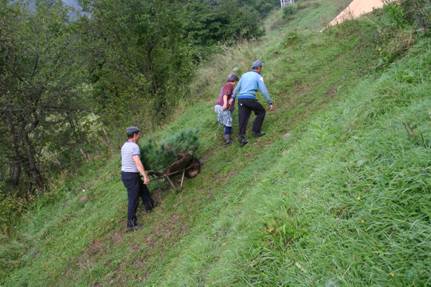
Picture 7. The primitive transport of the seedlings from the Nursery to the track road

Picture 8. The seedlings were loaded on the lorry for transportation to the Borsa

Picture 9. Seedling transportation from the Borsa outskirts to the Pietrosul Mt. can be made only with such caterpillar tractor
2.1.6 First plantation with Pinus mugo
One of the major objectives of the Project was to restore P. cembra / P.mugo / P. abies habitat on 50 hectares covering it first by planting 2500 seedlings of P. cembra and 2500 of P. abies as tall species. Then the 5000 seedlings of P.mugo have to be planted allover the same 50 hectares, but between the seedlings of the other two species, so that the seedlings of this species are not taken into account in the area (50 ha) calculation.
Plantation of the 5000 seedlings of P mugo was planned to be made on the years 2005 and 2006. Because
2.1.7 Planting design .
Specific data
Total project area to be planted: 50 ha ;
Average planting distance: 10 x 10 m;
Total seedlings per ha: 100;
Total seedlings for 50 ha: 5 000 of which 2 500 belong to P. cembra and 2 5 00 to Picea abies ;
In addition, a number of 5000 P. mugo seedlings have to be planted between the above two mentioned species at irregularly distance and consequently, they were not taken into account in the area calculation. The intention was to create, as much as possible, the past local landscape. This infusion with P. mugo will speed up restoration of the protection carpet from above the ground which soon contributes to the soil protection.
2.1.8 Seedlings distribution to the seedling beds
By using wood baskets (Picture 7), the 1700 potted seedlings were carried by the workers (on their back) to the planting bed / hole.
Because of the seedling and soil in bags weight and because of sloppy land and wild vegetation, this work was very hard and difficult.
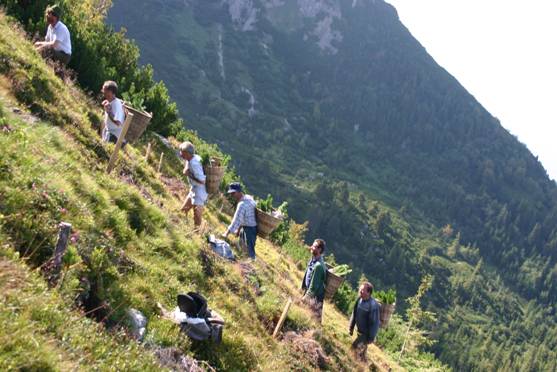
Picture 10. Seedling distribution to the seedling beds by using wooden baskets
2.1.9 Effective habitats restoration
2.1.9.1 Total Project task for the Action C.1
To restore P. cembra / P.mugo / P. abies habitats, 5 000 seedlings i. e.
2 500 P. cembra + 2 5 00 Picea abies have to be planted at about 10 x 10 m distance but not regular distance. Between the seedlings of the two species, 5000 Pinus mugo seedlings have to be planted again at irregular distance.
2.1.9.2 Effective plantation of Pinus mugo
Plantation of the entire area was, initially, foreseen to be done in the years 2004, 2005 and 2006. But, because of the available P. cembra and Picea abies seedlings, all these 50 hectares were planted with 5000 seedlings in the year 2004.
The rest of the seedlings, i. e. 5000 Pinus mugo had to be in the years 2005 and 2006.
In the year 2005, a number of 1700 Pinus mugo young trees were planted among the seedlings of the other two species. The rest of the 3300 seedlings of this species will be planted next year.
In conclusion, until now, 6 700 out of 10 000 seedlings were planted i. e. 67 % of the plantation task was fulfilled. The rest of 33 % or 3300 Pinus mugo seedlings will be planted during the vegetation season of the year 2006.

Picture 11. Pinus mugo seedlings in pots before planting

Picture 12. Planting activity

Picture 13. Planted P. mugo
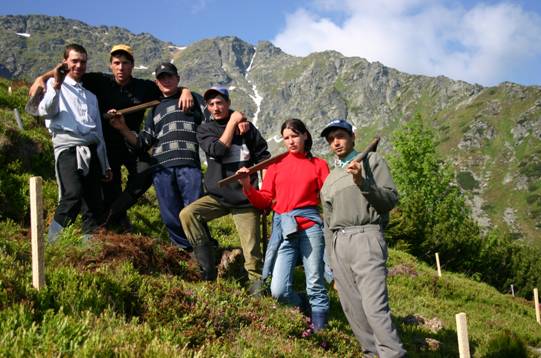
Picture 14. Part of the working team
Action E.3
2.2 Local workshops and stakeholder consultation meeting
On October 13, 2005 took place in the Borsa Town hall , the project second workshop and stakeholder consultation meeting. A total of 37 people, including local and regional authorities, and scientists attended the workshop
The workshop programme presented in Power Point was:
Scientific inventory of the herbaceous and woody species from the Pietrosul Rodnei Biosphere Reserve (Dr. Gh. Coldea).
Scientific inventory of the bird species from the Pietrosul Rodnei Biosphere Reserve (Dr. Iosif Beres).
Restoration Pinus cembra / P. mugo / Picea abies habitats: plantations with Pinus mugo (Dr. I. Blada, I. Muntean, S. Tanasie, A. Dragila and C. Dinu).
A high interest of the participants in supporting the project actions was the main conclusion of that workshop.
The stakeholder consultation meeting took place as the last indoor item where both the officials and scientists discussed and analyzed the present status of the Project. Discussions from the meeting were focussed on current problems that are facing not only the project but also the whole National Park. The financial support of the European Community was very much appreciated recognizing its contribution to the restoration of the habitats from the Pietrosul Rodnei Mountain . It was appreciated that the habitats restoration by planting according to the Project objectives is going on very well as 67 % of the of the objective was accomplished after two working seasons, only.
After the indoor meeting, the youngest participants have climbed the Pietrosul Mountain and visited the 2005 and 2004 plantations from the Project area. It was recognized that the plantations with the three species look very well even though a lot of difficulties were encountered during the seedlings transportation and plantation at high elevation.
Below are presented the two invitations. The first was sent to the European Council and to the External Team and the second one was sent to the Romanian participants.
On the next page are presented, in English and Romanian, the invitation to our workshop.
THE FOREST RESEARCH AND MANAGEMENT INSTITUTE OF BUCHAREST
THE FOREST STATE ADMINISTRATION OF THE MARAMURES COUNTY
THE RODNEI MOUNTAINS NATIONAL PARK
INVITATION
In the frame of the Action E.3 of the LIFE-Nature Project (LIFE 2003 NAT / RO / 000027 / REV) Restoration Forest Habitats from Pietrosul Rodnei Biosphere Reserve will be organized the second workshop. This workshop takes place on October 13, 2005 at the Borsa Town hall .
The workshop programme presented in Power Point is:
• Scientific inventory of the herbaceous and woody species from the Pietrosul Rodnei Biosphere Reserve (Dr. Gh. Coldea).
2. Scientific inventory of the bird species from the Pietrosul Rodnei Biosphere Reserve (Dr. Iosif Beres).
3. Restoration Pinus cembra / P. mugo / Picea abies habitats: plantations with Pinus mugo (Dr. I. Blada, I. Muntean, S. Tanasie, A. Dragila and C. Dinu).
In the same day, between 11- 18 hours, the participants will
visit the plantations from Pietrosul Mountain made last year and this year, as well (Hard boots and raincoat, necessary).
You are kindly asked to attend this workshop.
Project Manager: Ioan Blada, Ph. D.
Institutul de cercetari si amenajari silvice Bucuresti
Directia silvica Maramures
Parcul National Muntii Rodnei
INVITATÍE
Va anuntam ca în cadrul Actiunii E.3 din Proiectul LIFE-NATURA / intitulat Refacerea habitatelor forestiere din Rezervatia Biosferei Pietrosul Rodnei, se va organiza, în ziua de joi 13 Octombrie, 2005 la Primaria din Borsa, o reuniune de lucru la care se vor prezenta urmatoarele materiale:
Intre orele 9-11
1. Inventarul stiintific al florei (specii ierbacee si lemnoase) din Rezervatiei Biosferei Pietrosul Rodnei (Dr. Gh. Coldea).
2. Inventarul stiintific al pasarilor din Rezervatiei Biosferei Pietrosul Rodnei (Dr. Iosif Beres).
3, Refacerea habitatelor de Pinus cembra / P. mugo / Picea abies: plantatii cu Pinus mugo (Dr. I. Blada, I. Muntean, S. Tanasie, A. Dragila and C. Dinu).
Între orele 11-18 are loc deplasarea la Pietrosul Rodnei pentru a vizita plantatia executata cu Pinus cembra / P. mugo / Picea abies.
Sunteti invitat(a) sa participati la aceasta reuniune de lucru.
Manager proiect: Ioan Blada, Ph. D.

Picture 15. Of 37 participants to the indoor workshop, only 12 could climb the Pietrosul Mountain to see the planted area.
2.3 Public awareness
Presentations in Power Point of the Project results, for the public awareness took place in the following institutions:
Agricultural Institute of Cluj , May 13, 2005 ;
Forest Research Station of Cluj, May 13, 2005 ;
Faculty of Silviculture of the Brasov University , May 23, 2005;
Forest Research Station of Brasov , May 23, 2005 ;
Faculty of Biology of Bucharest , September 23, 2005 .
Forest Research and Management Institute of Bucharest , October 18, 2005 ;
It should be pointed out that the same material was presented in all the above mentioned institutions, and it will soon be posted on our website.

Picture 16 Project presentation at Nasaud High Scool
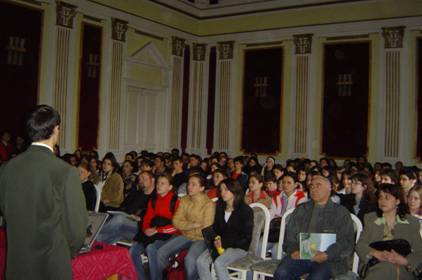
Picture 17 Project presentation at Nasaud High Scool

Picture 18. Presentation at the Brasov Forest Research Station
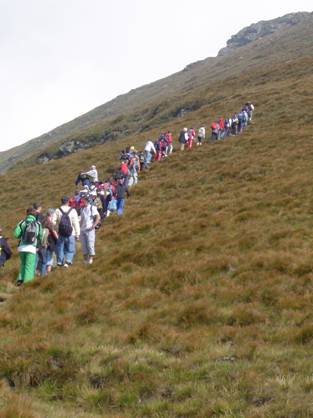
Picture 19. Departure to the Pietrosul planted area
Below is presented an example of announcement concerning the public awareness presentation at the Agricultural Institute of Cluj
A N U N T ( Anouncement )
În ziua de 13 Mai 2005, ora 12, va avea loc în aula Institutului Agronomic Cluj prezentarea lucrarilor proiectului international life -Natura întitulat:
REFACEREA HABITATELOR FORESTIERE DIN REZERVATIA BIOSFEREI PIETROSUL RODNEI
( Restoration Forest Habitats from Pietrosul Rodnei Biosphere Reserve)

Lucrarea, prezentata în Power Point, va ilustra nu numai ceea ce s-a realizat la Proiect ci si starea vegetatiei lemnoase din Pietrosul. La sfârsit au loc întrebari si discutii.
Prezinta: I. Blada, cercetator la Institutul de Cercetari si Amenajari Silvice, Bucuresti
2.1.10 Summary of project milestones fulfilled actions on
2004 and 2005 (Blue: fulfilled actions in 2004 / 2005)
(Red: delayed actions)
Milestone |
Name or n° of reference action |
Deadline |
Set up the Advisory Board and Management Project Team .
|
A.4 |
September 2003 |
Effective re-introduction by planting P. cembra species and restoration of P. cembra / P.mugo / P. abies habitat on 20 ha (remainder 30 ha) in the Zanoaga hollow from the Pietrosul Rodnei Biosphere Reserve (Part one).
|
C.1
|
October 2004 |
Effective re-introduction by planting P. cembra species and restoration of P. cembra / P.mugo / P. abies habitat on 20 ha (remainder 10 ha) in the Zanoaga hollow from the Pietrosul Rodnei Biosphere Reserve (Part two) |
C.1
|
October 2005 |
Effective re-introduction by planting P. cembra species and restoration of P. cembra / P.mugo / P. abies habitat on 10 ha (to get 50 ha as planned) in the Zanoaga hollow from the Pietrosul Rodnei Biosphere Reserve (Part three) |
C.1
|
October 2006 |
10 information panels planted in key places |
C.3 |
July 2004 |
Implementation of Long-term Conservation Management Plan by integrating the best measures for conservation of all flora and fauna habitats on 6 415 ha from the Pietrosul Rodnei Biosphere Reserve |
D.1 |
April 2006 |
First Local Workshop followed by an excursion to the project area.
|
E.3 |
June 2004 |
Second Local Workshop followed by an excursion to the project area.
|
E.3 |
June 2005 |
Third Local Workshop followed by an excursion to the project area. |
E.3 |
May 2007 |
Workstation Development |
F.2 |
December 2003 |

Picture 20 Ing Petrila Marius, our GIS specialist checking the geographical coordinates of the refugee chalet
• Financial summary for the years 2004 / 2005
(a) Total allocated in the Project.. . ..213 470 E
From the Table 3, the following details can be given:
(b) Total received advance from EC.... . 42 694 E
(c) Total spent from the EU budget (Table 2). 42 694.E
(d) The advance was exceeded by (Table 2) ...................6 441 E
(e) Total ICAS co-financing.(Table 2) ......................39 655 E
(f) Total Baia Mare co-financing .(Table 2) ..28 986 E
(f) Total co-financing (e) + (f) ... ......68 641 E
NOTE: the amount of 6 441 E was supported by the ICAS but the amount was not included at co-financing.
(g). Comments on the Personnel item (Table 1)
Table 1 shows a difference of 583 E between our Personnel calculation and EC on line form calculation, that require explanation:
according to our time sheets (which express the real cost) the total expenses for Personnel was 24 807 Euro;
according to the EC forms (to be fill in on line), the total amount for Personnel was 25 390 Euro;
the difference between 25 390 and 24 807 is 583 Euro and this is because of the on line programme require the average of annual gross salary to be used while our calculation was restricted only to the real working time;
the amount of 25 390 Euro was placed in the EU standard forms.
(h) Comments on Table 3
This table shows that out of 213 470 E allocated, 117 776 E were spent and credit balance at 30.11.2005 was 95 694 E.
Table 2. Summary of co financing
Co-financier |
2004 year |
2005 year |
TOTAL 2004-2005 |
||||
|
Overheads |
Total |
|
Overheads |
Total |
||
ICAS |
24749 |
2955 |
27704 |
10254 |
1697 |
11951 |
39655 |
FSAM Baia M |
22249 |
|
22249 |
6737 |
|
6737 |
28986 |
Total |
|
|
49953 |
|
|
18688 |
68641 |
Contributors |
2004 year |
2005 year |
Total |
C.E.as main financier |
27 340 |
15 354 |
42694 |
ICAS cofinancier |
27704 |
11951 |
39655 |
FSAM cofinancier |
22249 |
6737 |
28986 |
Total 1 |
|
|
111335 |
Diference to be recovered by ICAS |
|
6441 |
|
Total general |
|
117776 |
|
Table 3. Summary of allocated, spent and remainder budget
Budget Items |
Total allocated |
Total expenses 2004-2005 |
Credit Balance at 01.01.2006 |
Personnel |
69935 |
25390 |
44545 |
Travel |
8000 |
4272 |
3728 |
External assistance |
52297 |
28264 |
24033 |
Durable goods |
19390 |
18159 |
1231 |
Consumable material |
53300 |
36984 |
16316 |
Other costs |
1000 |
55 |
945 |
Total direct costs |
203922 |
113124 |
90798 |
Overheads |
9548 |
4652 |
4896 |
Total- l |
213470 |
117776 |
95694 |
(i ). Comments on the expenses from the Action D.1
In the year 2002 when the LIFE Project was prepared, three rangers were foreseen at the Action D.1 to be hired. Afterwards, the Romsilva National Administration of the Forests created the Rodnei Mountains National Park where three rangers paid by the Romanian Government, were hired. As for the year 2005, another two rangers were hired, i. e. five in total. Because that park entirely included the Pietrosul Rodnei Biosphere Reserve i t was un-necessary to hire other rangers. So that the LIFE project will not financially support any ranger.
4. Covering text concerning fulfilling the 2004 and 2005 activities
- In the year 2002 when the LIFE Project was prepared, three rangers were foreseen to be hired and paid from the Action D.1. Afterwards, the Romsilva National Administration of the Forests created the Rodnei Mountains National Park where the Pietrosul Rodnei Biosphere Reserve was entirely included. This National Park is financially supported by Romanian Government. Among other personnel, the staff of the Park includes five rangers. As consequence, no other ranger was hired at, and paid from the LIFE Pietrosul Project funds.
- Again, in the year 2002 when the LIFE Project was prepared, the Romanian legislation did allow to any state enterprises, including our partner from Baia Mare, to solve any work with their own Personnel. In the meantime the legislation was changed in the sense that any kind of work must be done using specialized private companies elected by competition among three candidates. The SC IURES COM SRL COMPANY located in Bistrita (that later on became SC REGFOR SRL Borsa) did earn the competition to make all our work from the following actions:
C1: Effective reintroduction of P. cembra and restoration P. cembra / P. mugo / Picea abies habitat by planting;
C2: Construction of a small size refugee chalet and toilet;
C3: Information panels construction and their installation
Initially, the payments of these works were foreseen to be done from Personnel category. Because the work fulfilled by the above mention company could not be paid from the Personnel category, a project budget revision was required . So, a REVISED PROJECT BUDGET was sent to the EC. This revised form of the budget, in which 52 297 E were moved from the Personnel to the External Assistance was approved by the European C. Enclosed, a Revised Project Budget copy is sent to you.
Conclusions
- As the approved project arrived late autumn of the year 2003, but not in June as expected, the work started in January 2004. However, it is evident now that the Project will be terminating in due course.
- At present, most of the actions were solved.
- The Project Work Plan with regard to the Action C.1, foresee:
to plant 50 hectares with 5000 seedlings of which 2500 belong to Pinus cembra and 2500 to Picea abies ;
in addition, on the same 50 hectares area, and between the seedlings of the two species, a number of 5000 Pinus mugo have to be planted
during the years 2004 and 2005, a number of 6500 seedlings were planted, of which 2500 belong to Pinus cembra , 2500 to Picea abies and 1700 to Pinus mugo , so that 67 % of the work plan was fulfilled.
the rest of the 3300 or 33 % Pinus mugo will be planted during the year 2006 and the ICAS has the necessary seedlings for this aim.
- It should be stressed that serious difficulties were encountered during fulfilling all sub-actions of the Action C1. For example, during the seedling transport of the seedlings to the Pietrosul, the caterpillar tractor did thrown on slope but fortunately, nobody was killed. However, the tractor was broken;
- The cooperation with the Forest State Administration of Maramures (FSAM) and with the Company that executed the field works was remarkable; otherwise planting could not take place;
- Local authorities, stakeholders, scientists, foresters, teachers greatly appreciated restoration of the Pietrosul habitats restoration through EC contribution;
- In the year 2004 and 2005, each contributor to the Project supported the following amounts: European Commission 42 694 Euro, ICAS 39 655 Euro and FSAM Baia Mare 28 986 Euro.
- The project team invite the EC authorities, including the External Team to visit how the Project is implementing.
Major conclusion
The Project Team is convinced that the Project will be successfully implemented in due course and in the frame of the allocated budget.



TECHNICAL REPORT 2006
LIFE 2003 NAT / RO / 000027 / REV
Restoration Forest habitats from Pietrosul rodnei biosphere reserve
Project Manager
Dr. Ioan Blada
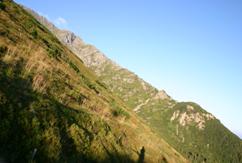
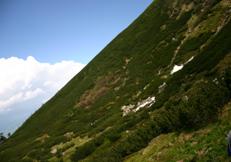
Period: January 1, 2004 - December 31, 2006
Bucharest 2006
Restoration Forest habitats from Pietrosul rodnei biosphere reserve
Introduction
The 2004 was the first year of the project that initially was planned to start on 01 June 2003 and to be finished on 01 June 2007 , i. e. 48 months duration. Because approval of the project has arrived too late, the work could not be start earlier than January 2004. However, taking into account the present results, one may assume that the project termination will take place in due course.
Project objectives
Restoration of P. cembra / P. mugo / Picea abies natural habitat on 50 ha from Zanoaga hollow of the Pietrosul Rodnei Biosphere Reserve. The area is shared, such as: P .cembra 25 ha and P. abies 25 ha ; the P. mugo bushes will be planted at irregular distances among the trees of the other two species, i. e. it shares the same surface.
Conservation of all flora and fauna habitats on 6 415 ha including P. cembra / P. mugo / Picea / abies one from the Pietrosul Rodnei Biosphere Reserve
Expected results
On immediate term :
Restoration of P. cembra / P. mugo / P. abies habitats on 50 ha
On medium term:
Creation better conditions of life for herbaceous flora and wildlife followed by a normal future development;
Preventing soil erosion and flooding;
On long term:
Creation of normal conditions for natural regeneration of the P. cembra /
P. mugo / P. abies habitats. Then, from Zanoaganucleus, these habitats extend little by little to the surrounding areas. It is assumed that P. cembra population from Pietrosul Mountain , which is very close to extinction, will be recovered once the new planted trees will start to produce seed; this biological phenomenon will occur after about 18/20 years after planting.
Preventing avalanche initiation.
Implementation long-term conservation management plan of all flora and fauna habitats on 6 415 ha of the Pietrosul Rodnei Biosphere Reserve, takes place.
It is important to stress that, in the mean time, on 46 399 ha area, the Rodnei Mountains National Park was created and the initial Pietrosul Rodnei Biosphere Reserve has been including into that Park. It means that the long-term Conservation Management Plan was already extended to the whole area, i.e. from
6 415 ha to 46 399 ha . By this Plan, will be integrated the best measures for conservation of all flora and fauna habitats at a larger scale. Owing to the sustainable conservation management, positive evolution of restoration process will be achieved.
A ction A.1
Foreseen tasks with Action A.1:
Assessment of the woody, herbaceous and rocky ecosystems / habitats from Pietrosul Rodnei Biosphere Reserve ( 6415 ha ) based on both GIS high-resolution satellite imagery and field survey.
Achieved results with Action A.1:
Digital distribution map of the flora and rocky ecosystems / habitats , including P. cembra / P .mugo / P. abies ones
There was obtained the distribution map of flora and rocky habitats with its associated geographic components. The GIS and remote sensing team of the Bucharest Forest Research and Management Institute, using his specific equipment (updated with the LIFE/Nature project financial support), fulfilled this work. The digital map was based on Quick-Bird satellite imagery, taken on July 10, 2004 , with spatial resolution at 0.6 m of the panchromatic band and 2.4 m multispectral.
The image was georefernced based on existing printed (1:5,000 scale) topographic maps. From these maps were collected (vectorised) contour lines and ground control points (GSP). Based on contour lines the digital elevation model (DEM) was build. Using DEM and GSP the ortho-rectification was done using Quick-Bird specific mathematical model within ERDAS Imagine software.
To take advantage of both spectral information (including near infrared, very useful for vegetation studies) and highest spatial resolution of panchromatic band a fusion of these components was performed. For detailed studies, the result was displayed as color infrared image (false color composite). Where the vegetation appears in red hues, this way of displaying, allows more details detection within vegetation cover. A version of "real" colors (vegetation appears in green hues) was displayed and printed as spatial map, to be more familiar for the public.
The resulted spatial Map.1 shows the woody and herbaceous and rocky ecosystems / habitats. The next operation was a field check of the visual image interpretation and georefernced accuracy evaluation. This task was done using a Trimble Pathfinder GPS. The accuracy evaluation shows the target of 1:5000 scale accuracy was achieved.
Final operation was the on-the-screen vectorization of the main limits of the flora and rocky ecosystems / habitats and encoding of each type of land cover. The result is a land cover stratum as shape file (Arc View) containing accurate geographic information that could be up-dated and combined with others geographic information, usable to build different maps and for spatial analyze (Map 1). Due to its very high spatial resolution, the maps allow to be seen not only ecosystems but the planted seedling beds of 80 x 80 cm size, too (Map 2).
It should be stressed that this map, which will be insert on our webpage, represents a premiere for the Pietrosul Rodnei Biosphere Reserve and for any other similar unit from Romania .
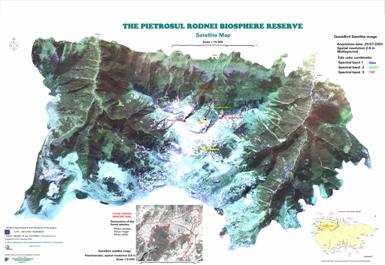
Digital distribution map of the Pietrosul Rodnei Biosphere Reserve
showing where the project site is places
Scientific inventory of herbaceous species (A.1) ( pictures)
Across the Pietrosul Rodnei Biosphere Reserve, a comprehensive inventory of the herbaceous species was made and it was already included in the Project webpage. This inventory showed that the Biosphere Reserve is extremely rich in species, and the following botanical characteristics are highlighted here:
a number of 568 herbaceous species distributed within 58 families, were found;
the Asteraceae and Poaceae families with 98 and 54 species, respectively, were the richest ones, while a number of 13 families have only one species, each one;
most species were recorded on alpine and sub-alpine pasturelands but the herbaceous flora found under the forest canopy was, as normal, poorer mainly in conifers forests;
for Romania, there were found 22 endemic species, 18 rare species, seven protected species and nine protected and included in the Red List species ( Table 1 );
a number of seven threatened species at European level included in the IUCN List were found in the Pietrosul Rodnei Biosphere Reserve ( Table 1 );
Table 1: List of endemic, rare, protected and Threatened species from the
Pietrosul Rodnei Biosphere Reserve
Endemic species for Romania |
||||
1 |
Achillea schurii Schultz-Bip |
12 |
Oxytropis carpatica Uechtr. |
|
2 |
Aconitum moldavicum ssp. simonkaianum |
13 |
Phyteuma tetramerum Schur |
|
3 |
Alopecurus laguriformis (Schur) Tzvelev |
14 |
Phyteuma wagneri A. Kerner |
|
4 |
Campanula serrata (Kit.) Hendrych |
15 |
Poa deylii Khrtek et Jirasek |
|
5 |
Centaurea pinnatifida Schur |
16 |
Primula leucophylla Pax. |
|
6 |
Cerastium lerchenfeldianum Schur |
17 |
Pulmonaria rubra ssp. filarzskyana Jav. |
|
7 |
Dianthus tenuifolius Schur |
18 |
Salix retusa ssp. kitaibeliana Willd. |
|
8 |
Erysimum wittmannii Zawadzki |
19 |
Scabiosa lucida ssp. barbata Nyar. |
|
9 |
Festuca rupicola ssp. saxatilis (Schur) R |
20 |
Silene nivalis (Kit.) Rohrb. |
|
10 |
Heracleum carpaticum Porc. |
21 |
Soldanella hungarica ssp. hungarica Sim. |
|
11 |
Heracleum palmatum Baumg. |
22 |
Thlaspi dacicum Heuffel |
|
Rare species for Romania |
||||
1 |
Alopecurus laguriformis (Schur) Tzv. |
10 |
Oxytropis carpatica Uechtr. |
|
2 |
Botrichium multifidum ( Gmelin) Rupr. |
11 |
Salix bicolor Willd. |
|
3 |
Carex bicolor All. |
12 |
Saussurea alpina (L.) DC |
|
4 |
Draba carinthiaca Hoppe |
13 |
Saxifraga carpathica Reichenb. |
|
5 |
Erigeron nanus Schur |
14 |
Saxifraga hieraciifolia Waldst. et Kit. |
|
6 |
Festuca porcii Hackel |
15 |
Senecio carpaticus Herb. |
|
7 |
Juncus castaneus Sm. |
16 |
Silene nivalis (Kit.) Rohrb. |
|
8 |
Kobresia simpliciscula (Wahlenb.) Mack. |
17 |
Thlaspi dacicum Heuffel |
|
9 |
Lycopodium alpinum L. |
18 |
Tozzia alpina ssp. carpatica (Wol.) Hayek |
|
Protected species for Romania |
||||
1 |
Angelica archangelica L. |
5 |
Pinus mugo Turra |
|
2 |
Gentiana lutea L. |
6 |
Rhododendron myrtifolium Schott & Kots |
|
3 |
Leontopodium alpinum Cass. |
7 |
Trollius europaeus L. |
|
4 |
Pinus cembra L. |
|
|
|
Protected species for Romania (Red List) |
||||
1 |
Angelica archangelica L. |
6 |
Heracleum carpaticum Porc. |
|
2 |
Aquilegia nigricans Baumg. |
7 |
Leontopodium alpinum Cass. |
|
3 |
Arnica montana L. |
8 |
Rhododendron myrtifolium Sch. et Kots |
|
4 |
Erigeron nanus Schur |
9 |
Silene nivalis (Kit.) Rohrb. |
|
5 |
Gentiana lutea L. |
|
|
|
Threatened species at European level (IUCN List) |
||||
1 |
Achillea schurii Schultz-Bip |
5 |
Plantago atrata ssp. carpatica (Pilg.) Soó |
|
2 |
Arnica montana L. |
6 |
Silene nivalis (Kit.) Rohrb. |
|
3 |
Campanula serrata (Kit.) Hendrych |
7 |
Tozzia alpina ssp. carpatica Woloszc. Hayek |
|
4 |
Gentiana lutea L. |
|
|
|
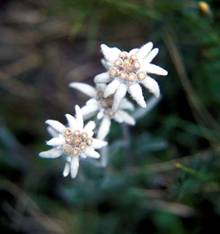
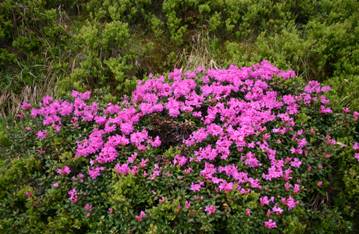
Leontopodium alpinum -----------------------------Rhododendron myrtifolium
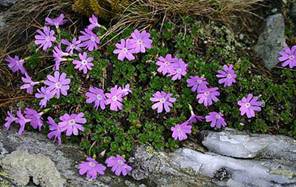

Primula minima ------------------------------------------Rhodiola rosae
Scientific inventory of tree and shrub woody species (A.1) ( pictures)
Comparing with herbaceous species, as expected, the number of woody species was much smaller. There were found 57 species, of which 14 trees, 26 shrub and 17 sub-shrub species. The following aspects should be stressed:
P. cembra, P. mugo, P. abies, Sorbus aucuparia , and Alnus viridis are the most important woody species within the Pietrosul LIFE project area;
P. mugo is included in the Annex I Habitats Types, Code 4070 from Natura 2000;
Picea abies and Pinus cembra are components of habitat type according to the Habitats Directives, Code 9410 and 9420, respectively;
Pinus cembra and P. mugo are included in the Romania Protected Species List ( Table 1 ).
Concerning P. cembra , it should be stress that on the Pietrosul, a large population was growing in the past but now, the number of remained old trees is less than 40 and most of them are very old and highly dispersed or even isolated each other so that the inter-pollination is restricted while the self-pollination is the rule. Only three young trees naturally regenerated were found. This demonstrates that the heavy infusion, via LIFE project, with new planted P. cembra seedlings will prevent the extinction of the species population from Pietrosul.
It is significant to note that during our investigations on the subalpine zone, within the project area, just in the Zanoaga Mare Hollow a (perhaps) new two needle dwarf pine form or variety unlike P. mugo was found. This atypical form is now testing including through genetic means.
Scientific draft concerning distribution and structure of the P. cembra / P.mugo / P. abies habitat in Pietrosul Rodnei Biosphere Reserve (A.1)
In order to get details about the distribution and structure of the woody species habitats, during the vegetation season of the 2005 year a comprehensive survey al over the Pietrosul Rodnei Biosphere Reserve was done. The survey focused on each of the three altitudinal levels of vegetation currently recognized, such as:
mountainous level with two sub-levels
average sub-level between 740 and 1100 m elevation;
high mountainous sub-level between 1100- 1500 m elevation;
sub-alpine level between 1500 and 1900 m elevation;
alpine level between 1900 and 2003 m elevation.
The mountainous level with its average sub-level between is characterized by the occurrence of the beech ( Fagus sylvatica ) and spruce ( Picea abies ) forests where Acer pseudoplatanus, Sorbus aucuparia and Betula pendula scattered trees can vegetate.
S ub-alpine level is characterized by the occurrence of the scattered or in groups, the following woody species: Pinus cembra, Juniperus sibirica and Rhodendron myrtifolium .
In its composition, the alpine level has small trees or bushes of Salix reticulate and Vaccinium gaultherioide.
It should be stressed that survey took into account not only woody vegetation but all environmental conditions in which it develops, such as: geology, geomorphology, hydrographic factors, soil,

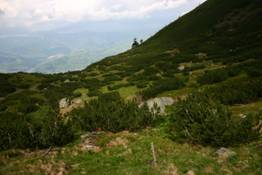
Picea abies, Pinus cembra and Pinus mugo associated species
Scientific inventory of bird species (A.1) ( pictures)
A very detailed inventory of the birds was made by a specialist in ornithology from outside of our Institute. Because the Institute has no an ornithologist, this work was sub-contracted.
Over Pietrosul Rodnei Biosphere Reserve, a total of 86 bird species distributed at 58 genera, 28 families and nine orders were recorded ( Table 2 )
With its 18 families and 53 species, the Passeriformes order is the largest while the Cuculiformes order with only one family and one species, is the smallest one;
The Turdidae family with its 10 species is placed in the top of the rank;
Of 86 bird species, 87 % are nesting within the Biosphere Reserve while 13 % are passengers;
Again, of 86 bird species, 10 are present on the Romanian Red List, while only one ( Aquila clanga ) can be found on the European one ( Table 3 )
Table 2: Birds taxonomy
Orders |
Families |
Genera |
Species |
Anseriformes |
1 |
1 |
2 |
Falconiformess |
2 |
6 |
12 |
Galliformes |
2 |
3 |
4 |
Charadriiformes |
1 |
2 |
2 |
Columbiformes |
1 |
1 |
2 |
Cuculiformes |
1 |
1 |
1 |
Strigiformes |
1 |
4 |
5 |
Piciformes |
1 |
4 |
5 |
Passeriformes |
18 |
36 |
53 |
Total |
28 |
58 |
86 |
Table 3: The Red List of the birds from the Pietrosul Rodnei
Biosphere Reserve (PRBR)
Species |
PRBR |
Europe ** |
Species |
PRBR |
Europe |
Circaetus gallicus |
+ |
|
Tetrao tetrix |
+ |
|
Circus pygargus |
+ |
|
Scolopax rusticola |
+ |
|
* Aquila pomarina |
+ |
|
Glaucidum passerinum |
+ |
|
* Aquila clanga |
+ |
+** |
Aegalius funereus |
+ |
|
* Aquila chrysaetos |
+ |
|
Monticola saxatilis |
+ |
|
*According to the ORNIS Committee List (Annex II), the three Aquila species are priority for funding under LIFE. ** Aquila clanga is including in the European Red List
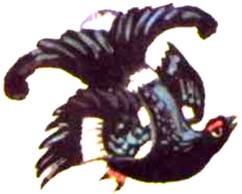

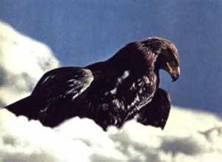
Tetrao tetrix ----------------Tetrao. urogalus ---------Aquila chrysaetos
Scientific inventory of mammal species (A.1) ( pictures)
The Mammals inventory has the following composition ( Table 4):
Forty one species distributed in six orders and 17 families;
According to the Romanian low 462 / 2001, six species require strict protection and they are included in the Red List, such as: Canis lupus, Lynx lynx, Neomys anomalus, Sicista betulina, Sorex alpinus and Ursus arctos ;
Of the European Red List, the following species are living in the Biosphere Reserve, as follows: Lynx lynx, Ursus arctos Canis lupus, Felis silvestris.
In the past until recently, the illegal hunting caused serious damages in wildlife. Also, the shepherds and local people and the tourists used to collect wild flowers and together with the domestic animal grazing they represented a destructive factor to the flora and fauna. It should be stressed that the factors contributing to the degradation of flora and fauna, mainly wildlife, significantly decreased in favor of restoration. This is because since early 2004, the Pietrosul Rodnei Biosphere Reserve was included within the Rodnei Mountains National Park which is administrated by the Romsilva National Forest State Administration . This National Park was provided with a staff, including 10 rangers. During the zear 2007, another two rangers will be hired. It is assumed that this guard team is able to take care of the whole Rodnei Mountains National Park area, including Pietrosul Rodnei Biosphere Reserve and the Pietrosul LIFE Nature restored habitats. Owing to this situation, the Project team has considered that it is not necessary to hire another parallel staff of rangers.
Table 4 shows that the Mammals Red List for the Pietrosul Rodnei Biosphere Reserve (which is valid for Rodnei Mountains National Park , as well) includes many in danger species, Ursus arctos and Canis lupus among them. Though, it is not present in this Red List, the black goat ( Rupicapra rupicapra )
from Pietrosul used to be considered in danger species because of the past illegal hunting. Due to the guard team of the Park, the situation was significantly improved.
Tab. 4: The Mammals Red List for the Pietrosul Rodnei Biosphere Reserve
|
Species |
Romanian Red List |
European Red List |
• |
Canis lupus |
+ |
+ |
• |
Felis silvestris |
+ |
|
• |
Lynx lynx |
+ |
+ |
• |
Muscardinus avellanarius |
|
+ |
• |
Myotis blythi |
+ |
|
• |
Neomys anomalus |
+ |
|
• |
Rhinolophus ferrumequinum |
+ |
+ |
• |
Rhinolophus hipposideros |
+ |
+ |
• |
Sciurus vulgaris |
|
+ |
• |
Sicista betulina |
+ |
+ |
• |
Sorex alpinus |
+ |
|
• |
Ursus arctos* |
+ |
+ |
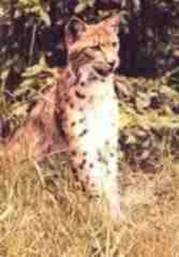
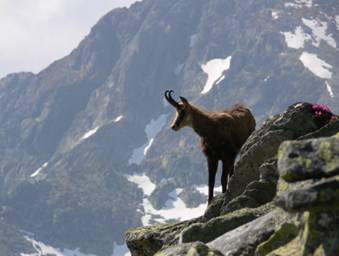
Lynx lynx -------------------------------------Rupicapra rupicapra
NOTE:
The inventories of the following three categories of fauna were not foreseen as project tasks but the inventories were made
Fishes inventory
Table 5: Fishes inventory
|
Species |
|
Species |
1 |
Cottus gobio L. |
4 |
Salmo trutta fario L. |
2 |
Cottus poecilopus Heck. |
5 |
Thymallus thymallus |
3 |
Phoxinus phoxinus L. |
|
|
Amphibians inventory
Table 6: Amphibians inventory
Species |
Species |
Bombina variegata |
Salamandra salamandra |
Bufo viridis |
Triturus alpestris |
Rana dalmatiana |
Triturus montandoni |
Rana temporaria |
|
Reptiles inventory
Tab. 7: Reptiles inventory
|
|
Anguis fragilis |
Natrix natrix |
Lacerta abilis |
Vipera berus |
Lacerta vivipara |
|
Purchasing durable goods from Action A.1
The following durable goods were purchased: GIS soft upgrading; hardware upgrading; digital camera; Quick Bird satellite imagery. These durable goods have been currently used for implementation of the project specific actions.
It is recognized that without the above mentioned equipment, some project actions could not be solved.
A ction A.2
Foreseen tasks with Action A.2:
P reparation of the technical management plan aiming at P. cembra species re-introduction and P. cembra / P.mugo / P. abies habitat restoration (A.2)
Achieved results with Action A.2:
T echnical plan aiming at habitat restoration
A technical management plan was conceived, comprising step by step all activities aiming at P. cembra species re-introduction and P. cembra / P.mugo / P. abies habitat restoration on 50 ha . This plan was made and already applied as a guide during the last three years in order to ensure the success of Pinus cembra and Picea abies re-introduction by planting as specified with the Action C.1. This project comprises all actives connected with the objective to be reached, such as: techniques for planting stock production, including seed origin, seed collection and processing, nursery techniques, planting technique, etc and all concerned costs.
Action A.3
Foreseen tasks with Action A.3:
Long-term Conservation Management Plan to enforce sustainable activities of all flora and fauna habitats from Pietrosul Rodnei Biosphere Reserve
Achieved results with Action A3:
Preparation Management Plan for the Pietrosul Rodnei National Park including Pietrosul Rodnei Biosphere Reserve
The Pietrosul Rodnei National Park did not exist in the year 2002 when the LIFE-Nature Application Forms were prepared. As state institution, it was created in the 2004 year when the Pietrosul Rodnei Biosphere Reserve was included within it. For this reason the elaboration of Management Plan was foreseen for the Pietrosul Rodnei Biosphere Reserve including the Pietrosul new habitat created through the LIFE-Nature Project.
Taking into account the inclusion of the Biosphere Reserve and project area inside of National Park, the present management plan was extended to the whole National Park with specific references to the LIFE Pietrosul project area.
The management plan includes actions to be taken during life project and established working framework for long-term conservation and management for the whole National Park. Furthermore, the plan integrates the economic and conservation activities in a holistic concept for sustainable development of the area in question with special emphasis to specific actions regarding woody habitats restoration and conservation of all flora and fauna habitats. Previously, through the three workshops (preparatory, intermediary and final) there took place a consultation process with local administrations, stakeholders and some local people, in order to create a working framework for local people. Members of Commission of the Nature Monuments , staff and Scientific Council of the National Park and Life project team attended in the management plan preparation.
It should be stress that alongside the foreseen management action concerning the National Park, specific protection and conservation measures for project plantation were inserted in the management plan. Based on this plan, the Life project actions will be continuing, so that, long-term conservation of all flora and fauna habitats, including P. cembra / P. mugo /P. abies one will be achieved.
Action A.4
Foreseen tasks with Action A.4:
Set up the Advisory Board and Management Project Team
Achieved results with Action A.4:
Workable Advisory Board and Project Team
To ensure the correct implementation of the project, on January 2004, the A dvisory Board and Management Project Team were set up.
The Advisory Board consists of 17 members and includes representatives of the local authorities of the economic and cultural institutions, land owners, forest administrators, fisher men and hunters and the Forest Research Institute representatives, as well. The main task of this Advisory Board is to ensure the project implementation, acting as a working framework. The board has had two meetings yearly where the project manager, presented the achieved results followed by discussions..
The Management Project Team consists of 14 members and it is composed of scientists whom background is connected with the scope of the project. The status of the project implementation was reported to the Advisory Board.
Action C.1
Foreseen tasks with Action C.1
Effective re-introduction of P. cembra and restoration of P. cembra / P.mugo / P. abies habitat by planting in the Zanoaga hollow from the Pietrosul Rodnei Biosphere Reserve
Achieved results with Action C.1:
Sticks preparation
A number of 12 350 conifer wood sticks were prepared to be used for land picketing. The stick dimensions were 100 cm long, 5 cm wide and 3 cm thick.
Land marking / picketing
This was the first field operation aiming at marking the place where the seedling bed has to be hoed . To be visible from distance, in the years 2004, 2005 and 2006 each of the 12350 seedling beds covering 50 ha were marked by prepared sticks. The sticks helped the worker to locate the place where the seedling bed has to be prepared.




On the back sticks transport, picketing (upper pictures) and the
Picked area (Piciorul Mosului) where avalanches occurred
Seedling bed or site preparation
The operation of hoeing of the seedling bed took place, immediately after the land picketing, i. e. mid June of the years 2004, 2005 and 2006. The seedling bed dimensions were of 80 cm x 80 cm a 20 cm depth. Because of the extremely harsh environment conditions (compact and/or lack of soil, dense Vaccinium sp. and herbaceous layer, stony ground, presence of bushes, etc.), this operation was made by the mountain special hoe. According to the site conditions, two kinds of tools were used, such as: the hoe when the soil was rock less and crowbar when the seedling bed substratum consisted more of stones than soil. By this way, a total of 12350 seedling beds were prepared
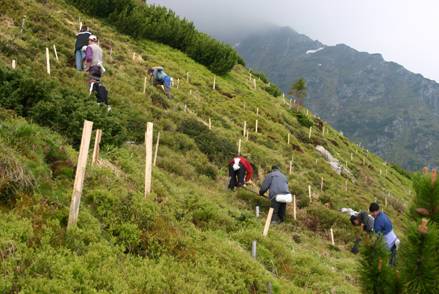
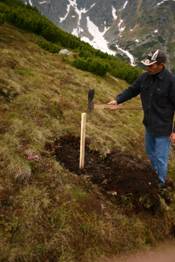
Seedling beds preparation
Seedling origin and their production
The P. cembra reintroduction and restoration of P. cembra / P.mugo / P. abies habitats was conceived to be made according to the genetic and ecological requirements. For this reason, P. cembra seedlings originate in the natural population Lala Valey near the Inau Mountain , a massive included, as Pietrosul, in the same Rodnei Mountains range. Therefore, the Lala Valey population has the same genetic structure and ecological requirements as that from Pietrosul Mt. where the project area is placed. Prior to launch the Project, these seedlings were already produced in the Sinaia Nursery belonging to the Bucharest Forest Research and Management Institute. The seedlings were grown in individual plastic bags fill in with acidophilus spruce humus. At the planting moment some of seedlings were seven to nine years old and they were very ell developed and health (See the nursery picture). Each seedling including potted soil has weighted between 4- 6 kg . Using potted seedlings ensures the planting success.
Picea abies and Pinus mugo seedlings have their origin in the Pietrosul Mountain natural population, i. e. very close to the project area.
To anticipate an answer to the question why not the Pietrosul P. cembra provenance was used for its population restoration, the following answer is given: just because, as earlier stated, the Pietrosul natural population is very close to extinction and the resulted seed / seedlings are from self / pollination and such seedlings / tree have very low survivals.
All the seedlings were produced by the ICAS as beneficiary / partner at its Sinaia Nursery located at about 700 m elevation. As mentioned in the Application Forms, the cost of the seedlings represents almost the entire Beneficiary's co-financing.

. 
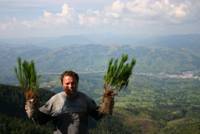
The Valea Larga Nursery from Sinaia (ICAS owner)
Pinus cembra (upper picture) and Pinus mugo seedlings (green darker color seedlings from lower pictures) at age seven prior departure to Pietrosul for plantation (Original I. Blada)
Seedlings transport
The seedling transportation took place from Sinaia Nursery to Borsa and then up to Pietrosul Mt. proved to be a very difficult task because:
the seedlings were grown in plastic pots fill in with soil and for this reason, they could not be overlap during transportation;
the Sinaia Nursery is placed in a hollow and because of this, the seedling transportation to the accessible road for trailer had to be made by a cart pulled by a horse from 600 to 750 m elevation;
then the seedlings were loaded in big trailers and transported about 650 km to the Borsa down town;
then the seedlings were transferred on four powerful lorries and transported seven km to the Borsa outskirts placed at 700 m elevation where the seedlings were unloaded;
then the seedlings were transported to the mountain planting site at about 1700 / 1800 m elevation; only a caterpillar tractor could make this transport on a very bad and sloppy primitive road, (See photo); only 300 seedlings could be taken on each drive / transport and two drives a day; 20 transport / days; a number of 20 days were necessary for 12 350 seedlings transportation from Borsa outskirts intermediate deposit to the Pietrosul Mt.
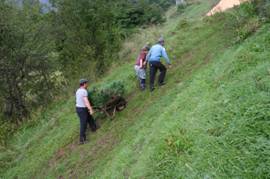
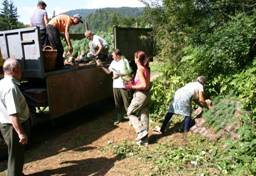
From Sinaia Nursery to the access road From Sinaia Nursery access road to Borsa outskirts
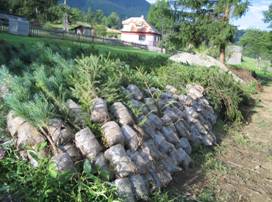

Intermediate deposit at Borsa outskirts From Borsa outskirts to Pietrosul at 1700 m a.s.l.
Seedlings distribution to the seedling beds
By using wood baskets, the 12350 potted seedlings were carried by the workers (on their back) to the planting beds distributed all over 50 hectares . Because of the basket weight (about 30 kg ) and sloppy land and wild vegetation, this work was very hard and difficult. For transportation 12350 potted seedlings, about 400 up and down runs took place.
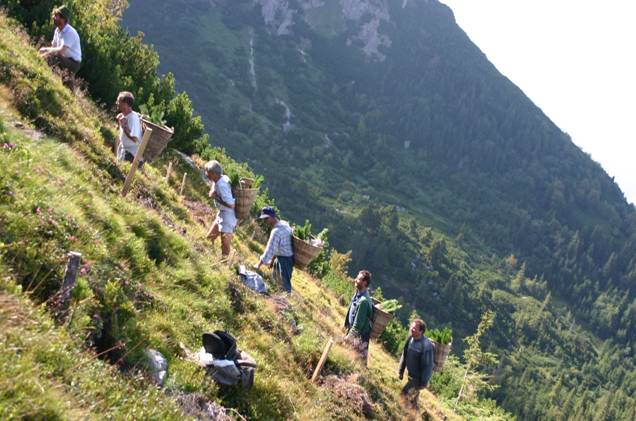
On the back by baskets transportation seedlings to the seedling beds
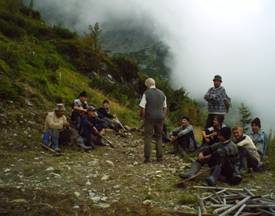
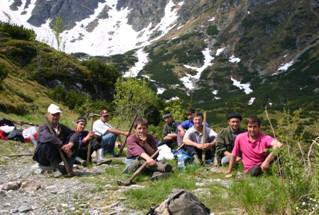
The working team rests after a hard working day
B orrowed soil transport
On some parts of the planting area, about 1000 seed bed required borrowed soil. This soil was transported by the caterpillar tractor from 800 m elevation outside Biosphere Reserve, to about 1700 m elevation where it was deposited. From that place, using wood baskets, the workers carried the soil on their back to the soil less seedling beds. It was a hard work.
Pl anting site, p l anting design and plantation
The planted area is laying out on the northern slope of Pietrosul Mt. between 1600- 1990 m elevations, namely across the Zanoaga Mare and Piciorul Mosului .
The initial foreseen planting design . Because an ecological plantation was assumed to be made, the tree too tree distance varied between 2 to 20 m , i. e. a 10 x 10 m average distance was taken into account. The intention was to restore the past local landscape, if possible. For this reason, an irregular planting framework was adopted. It is well known that P. cembra and P. abies trees are "tall" species while the P. mugo is a dwarf bush trees. Therefore, the 5000 P. mugo seedlings were planted (over the same 50 hectares ), at irregular distance, among the other two tree species. In other words, it was not taken into account at the area calculation. This infusion with P. mugo will speed up restoration of the above ground carpet which soon contributes to the soil protection.
The real applied planting design : Taking into account the newly acquired information about the planting area, the initial plan was slightly improved. It was learned that after previous trees cutting, the Piciorul Mosului steep slope became a place with avalanche occurrence. Two avalanches occurred on winters of 2005 and 2006 when five people were killed. Consequently, in order to prevent the avalanche initiation it was decided to increase the plantation density by planting 5 550 seedlings (2 350 P. cembra and 3 200 Sorbus aucuparia local provenance) in addition, so that on the same 50 hectares , altogether, 15550 instead 10 000 seedlings were planted. Sorbus aucuparia is naturally spread all over the Pietrosul sub-alpine ecosystem where at its early age it growth faster than any other local species and in addition resistant to harsh climatic conditions. It is expected that at least for the long term, this mixed population will play a positive role in avalanche control. It should be stressed that in the first version of the Application forms of this LIFE project, S. aucuparia was proposed to be included in the P. cembra / P. mugo / P. abies habitat but the proposal was rejected during the Application revision at European Commission level. This species can not be missed from Pietrosul sub-alpine habitats / ecosystem.
The plantation was made in late August of the 2004, 2005 and 2006 years, consecutively. Plantation hole was of 30 x 30 cm deep and placed in the center of the seedling bed. Each seedling of P. cembra and P. abies was planted separately in its whole while P. mugo and S. aucuparia one seedling of which were planted in the same whole. At early age and in sub alpine zone, the S. aucuparia growth much faster than any other woody tree species, so that the taller and denser the trees the most efficient against avalanche initiation. That is the reason why the
S. aucuparia was planted on the avalanche track. It should note that all 10000 seedlings foreseen initially were grown in plastic bags and planted bag less; this working procedure ensure a high level of surviving or success. The other 5550 seedlings were planted with bare roots some losses are expected. The in addition 5500 planted seedlings, including the man-power, were not included in the project expenses.


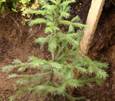
P. cembra P. mugo P. abies
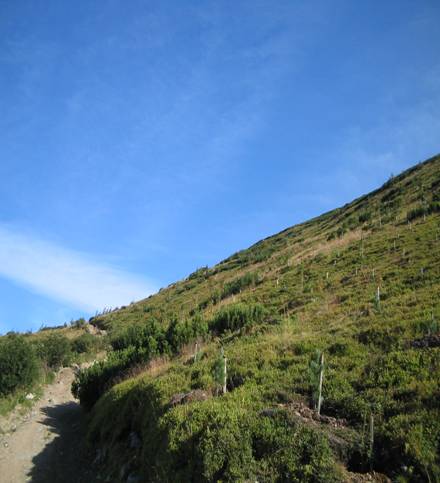
A sam of planted area
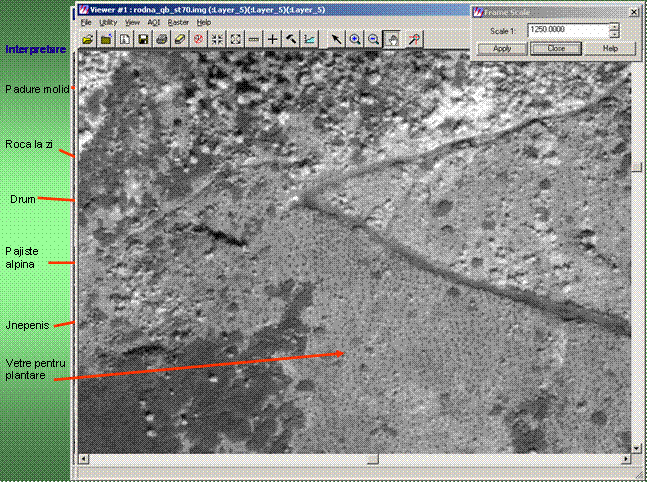
Quik Bird Satellite Imagery taken on July 10, 2004 : the seedling beds of 80 x 80 cm size can be seen from satellite
Action C.2
¦ Foreseen tasks with Action C.2
Construction of refugee chalet and a toilet
¦ Achieved results with Action C.1:
C halet and toilet constructed
In order to sheltering scientists and technicians and workers during the project implementation and rangers during Management Plan implementation, a refugee chalet was built alongside the LIFE-Nature project area.. Initially, a one room chalet was planned but finally a two room chalet including an attic was built. The conifer wood was used as basic material for construction of all components such as: infrastructure, walls, roof of shingle, doors and windows. For the indoor against cool protection a Rigip isolation layer was placed on the inside face of the walls. For a better outdoor protection against moisture, the external walls of the refugee chalet were painted using a yellowish oil paint. For the same reason, the roof was painted with a two layers mineral oil of dark color. The inside refugee chalet was equipped with superposed beds and other strict necessary equipment. Altogether, 16 persons can be accommodated in the two rooms and the attic. At about 150 m away from chalet, a primitive toilet was built. It should be stressed that the amount of currency foreseen in the Application Forms for this action was by far sub-evaluated and for this reason, the Forest Administration of the Maramures County and the Borsa Forest District) contributed free of charge with woody materials and other things.
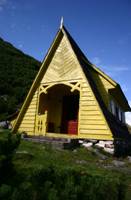


Implementation of the Action C.1 could not take place without this chalet
Action C.3
¦ Foreseen tasks with Action C.3
Information panels, construction and their installation
¦ Achieved results with Action C.3:
Panels construction and installation
Ten information panels, five in Romanian and five in English, were made on plastic material. The panel text (See the enclosed photos), written electronically using the Corel Program, comprises the European Community recommendations, such as:
the LIFE logo and partners logos placed in front of the panel;
the project objectives;
the project major actions;
a specific recommendation to the public to protect the planted trees and all flora and fauna species from the whole Biosphere Reserve.
the satellite map of the Pietrosul Rodnei Biosphere Reserve was placed on the panel lower side.
The panels were installed in strategic places accessible and visible to the public
With regard to the way the panels were installed, it should be stressed that a Romanian together with an English version of the panel were placed on the same 1 m tall x 1 m wide board, i. e. one version was inserted on the back of the other. In its upper side, each panel was equipped with a roof while in the lower side with two feets
Because the allocated amount for this Action was not entierly spent, some other panels could be order in the 2005 year.
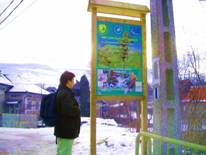

The first panel was installed at the entrance in Borsa while the second one inside
near the tourist road that climbs to the Pietrosul Pick
Action D.1
¦ Foreseen tasks with Action D.1
Implementation of Long-term Conservation Management Plan by integrating the best measures for conservation of all flora and fauna habitats from the Pietrosul Rodnei Biosphere Reserve
¦ Achieved results with Action D.1 :
Implementation of Management Plan already started
This process had to start on April 2006 but because the Management Plan was finished on December the same year, it starts fully now on early January 2007. However, prior conceiving the Management Plan, the process of public awareness was launched since 2004 year. Installing the 10 information panels containing specific inscriptions regarding objectives and importance of the LIFE-Nature project for the Pietrosul Rodnei Biosphere Reserve was considered as first important action of public awareness. Then, in the framework of the public awareness, information concerning the project actions and results, were presented in Power Point in the following institutions: Agricultural Institute of Cluj, May 13 2005; Forest Research Station of Cluj, May 13, 2005; Faculty of Silviculture of the Brasov University, May 23, 2005; Forest Research Station of Brasov, May 23, 2005; Faculty of Biology of Bucharest, September 23, 2005; Forest Research and Management Institute of Bucharest, October 18, 2005; Nasaud High School, November 22, 2005.
Since the last two years, the staff of the Rodnei Mountains National Park has written a Ranger Instruction-Guide for the five rangers guard team. This guide foresee details about how the ranger has to act in all possible circumstances in order to prevent any damages to the flora and fauna habitats from the whole Rodnei Mountains National Park which includes the Pietrosul Rodnei Biosphere Reserve and the Pietrosul LIFE area, as well. The staff of the Park, together with the LIFE project team, based on the written Guide, has made a theoretical instruction to the guard team. The access of the tourists and local people to the project area was reduced.
Other restrictive actions were established, as follows:
reducing access of the tourists and local people to the important birds nesting areas and to those areas with a higher frequency of carnivores, mainly Ursus arctos, Canis lupus and Marmota marmota ;
the access of the armed people inside National Park was totally and permanently prohibited;
a strong control of the hunters and stray dogs;
the project area of 50 hectares was established as special protected area.
An agreement with the mountain police service was established and their help in conflict extinction has been essential.
At present, the Management Plan is ready and starting with early January 2007, the integrated measures concerning protection and conservation of the flora and fauna habitats from the Rodnei Mountains National Park (including the Pietrosul Rodnei Biosphere Reserve and the Pietrosul LIFE area, as well), have been implementing in full, as defined in the Plan objectives. Owing to the above mentioned measures, flora and fauna habitats / species will have better conditions for conservation and development than in the past.
Action D.2
¦ Foreseen tasks with Action D.2
Monitoring of evolution process of P. cembra species re-introduction and P. cembra / P. mugo / P. abies habitat restoration to the end of the project
¦ Achieved results with Action D.2 :
Preliminary observations
This action was planned to be solved next year. However, since 2005 year, 10 (instead of three as foreseen) permanent sample-plots were marked across the project area. Each plot with a circle form with 13 m radius was marked at its centre with a red stick to be seen from distance. Within each circular sample an inventory of the seedlings was made in the autumns of 2005 and 2006 years. The plantation average success (%) per species was very high, such as: 97 % in P. cembra and 95 % in P. mugo and P. abies . The next monitoring will be done on early June 2007, after snow melting when some other traits will be recorded, such as: growth and behavior or resistance to harsh climate. Then a final draft before project termination will be compiled.
It must be stress that, in August 2007, the died seedlings will be replaced; the expenses will be supported by ICAS.


Action E.1
¦ Foreseen tasks with Action E.1
Set up the project website
¦ Achieved results with Action E.1 :
Workable website
On behalf of the LIFE Project, on January 2005, a website was opened at the following address:
http://www.icassv.ro/life_pietrosu
Action E.2
¦ Foreseen tasks with Action E.2
Design, print and disseminate informative materials
¦ Achieved results with Action E.2
Printed brochure and two leaflet
There were designated and printed a brochure and a leaflet containing scientific information about re-introduced P. cembra species and restored P. cembra / P. mugo / P. abies habitat. It was demonstrated the way through which this re-introduction and restoration was achieved. The brochure and leaflet contain integrated measures and results with regard to protection and conservation habitats not only woody but herbaceous, bird and carnivore species from the Rodnei Mountains National Park including Pietrosul and LIFE project area. By using the ICAS printing equipment and materials, 4 000 brochures and 2000 leaflets (in Romanian: PLIANTUL NR. 1 and PLIANTUL NR. 2, 1000 for each) were printed and partially were already disseminated inside the country. These materials, will be distributed free of charge in schools from Maramures County , including Borsa town and in key points for tourists. The rangers have also the task to distribute them. The main universities, forest districts from mountainous regions, non governmental organizations, and people involved in nature protection will be another beneficiary category of these printed materials.
The materials will help at gaining acceptance and collaboration from local communities, as a basis for implementation of the information exchange with different bodies, such as national authorities, stakeholders, LIFE project beneficiaries, etc.
Action E.3
¦ Foreseen tasks with Action E.3
Local workshops and stakeholder consultation meetings
¦ Achieved results with Action E.3
Workshops and stakeholder consultation meetings
First local workshops and stakeholder consultation meeting was held o n October 1, 2004 , at the Borsa Town , with the following schedule:
Presentation of the Project solved actions during the 2004 year (I. Blada and A. Filip);
Presentation of the Rodnei Mountains National Park : images and figures (D. Jauca and A. Hadarau).
Stakeholder consultation meeting.
Visiting the 50 hectares planted area with P. cembra and P. abies in the Zanoaga Hollow and Piciorul Mosului from the Pietrosul Rodnei Mountain.
The workshop was attended by 37 persons belonging to: local authorities, local and regional forest administrations, representatives of local economy, and representatives of the Commission of the Nature Monuments, the LIFE epresentatives, fishermen and hunters.
The first two items were presented on Power Point followed by discussions and questions. Plantation of 50 ha , placed on difficult geographic conditions, was very much appreciated.
After presentation of the first two items, stakeholder consultation meeting took place. Discussions were focused on current problems that are facing not only the project but also the whole National Park. It was welcomed the European Community financial support to the project.
After indoor meeting, in a very sunny afternoon, the younger participants climbed the mountain and visited the planted area where the encountered problems were presented.

Second local workshops and stakeholder consultation meeting
The project second workshop and stakeholder consultation meeting took place in the Borsa Town Hall , on October 13, 2005 ,. A total of 38 people, including local and regional authorities, and scientists attended the workshop.
The workshop programme presented in Power Point was:
Scientific inventory of the herbaceous and woody species from the Pietrosul Rodnei Biosphere Reserve (Dr. Gh. Coldea).
Scientific inventory of the bird species from the Pietrosul Rodnei Biosphere Reserve (Dr. Iosif Beres).
Restoration Pinus cembra / P. mugo / Picea abies habitats: plantations with Pinus mugo (Dr. I. Blada, I. Muntean, S. Tanasie, A. Dragila and C. Dinu).
A high interest of the participants in supporting the project actions was the main conclusion of that workshop.
The stakeholder consultation meeting took place as the last indoor item where both the officials and scientists discussed and analyzed the present status of the Project. Discussions from the meeting were focused on current problems that are facing not only the project but also the whole Rodnei Mountains National Park . The financial support of the European Community was very much appreciated recognizing its contribution to the restoration of the habitats from the Pietrosul Rodnei Mountain . It was appreciated that the habitats restoration by planting according to the Project objectives is going on very well as 67 % of the of the objective was accomplished after two working seasons, only.
After the indoor meeting, the youngest participants have climbed the Pietrosul Mountain and visited the 2005 and 2004 plantations from the Project area. It was recognized that the plantations with the three species look very well even though a lot of difficulties were encountered during the seedlings transportation and plantation at high elevation.
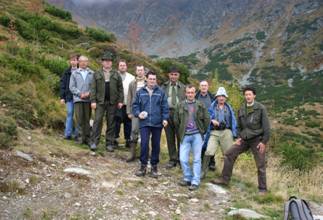
Only 12 young participants have climbed
the Pietrosul Mountain to see the planted area
Public awareness
In the framework of the public awareness, information concerning the project actions and results, were presented in Power Point in the following institutions:
Agricultural Institute of Cluj , May 13 2005 ;
Forest Research Station of Cluj, May 13, 2005 ;
Faculty of Silviculture of the Brasov University , May 23, 2005;
Forest Research Station of Brasov , May 23, 2005 ;
Faculty of Biology of Bucharest , September 23, 2005 ;
Forest Research and Management Institute of Bucharest , October 18, 2005 ; Nasaud High School , November 22, 2005 .

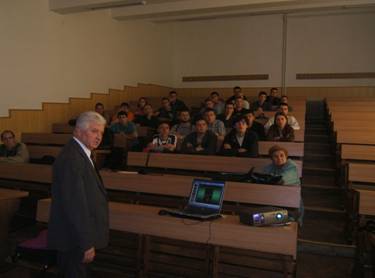
Between September 19-23, 2007, the LIFE project manager has organized Valiug, Romania, an international IUFRO Conference in five needle pines, including Pinus cembra where 37 scientists from 11 countries attended. A Power Point presentation about the Pietrosul LIFE-Nature project and the first film were presented during this Conference. As specialists in pines, the attendees highlighted the importance of Pinus cembra reintroduction and Restoration of Pinus cembra / P. mugo / Picea abies habitats from Pietrosul

Some participants to the IUFRO Conference
Action E.4
¦ Foreseen tasks with Action E.4
Video documentaries and media presentations
¦ Achieved results with Action E.4
Video documentary films
First video documentary film ( Title: Refacerea habitatelor or Habitats restoration )
Images for the first film were collected during the year 2005 and film was finished on early January 2005. The intention was to show how the plantation and its associated actions are going on in difficult mountainous conditions. Seeing the film sequences, one can see how danger was the seedling transport, on a primitive bad road, from Borsa to Pietrosul at about 1700 m elevation. Heavy action connecting with caring sticks and seedlings on the worker back over the very sloppy planting area, digging or hoeing seedling beds and plantation in a stony and sloppy land were also caught in the film. The film duration is about 25 minutes.
According to the Standard Provisions recommendation, the LIFE logo the recognition Community financial contribution was clearly inserted in the film.
Second video documentary film (( Title: Date despre vegetatia din Pietrosul or Data about vegetation from Pietrosul Rodnei) )
This film presents details about flora from the Pietrosul and its surroundings. Images were collected during the vegetation season of the year 2006 and the film was ready just before the end of the year. The duration of the film is about 50 minutes
The two documentary films will be displayed in already planned public awareness regarding the LIFE project actions and its acquired results, in the third project workshop, and on TV. The film will be presented in national and international meetings on nature habitats restoration and conservation.
In order to disseminate the LIFE project results, DVD copies of the films will be distributed to different organizations involved in nature protection, universities and some high schools.
The address where the two film masters are deposited at the following film Company:
Company: Albu Mihai Liviu Asociatie Familiara
Adress: Str. Stavilarului No. 6, Borsa, Judetul Maramures , Romania
E-mail: studio_aml@yahoo.com
Durable goods procurement in Action E.4
In the framework of the project, a Sony video camera was purchased. It proved to very useful to collect images for films and other aspects connected to the project area.
Action F.1
¦ Foreseen tasks with Action F.1
Project management and monitoring
¦ Achieved results with Action F.1
Reports
Two annual technical and financial progress reports (2004, 2005), one technical and financial interim report (2006) and an audit interim independent report (2006) were prepared and send to the European Commission and external monitoring team.
Action F.2
¦ Foreseen tasks with Action F.2
Workstation Development
¦ Achieved results with Action F.2
Purchased equipment
In the frame of this action, the following durable goods were purchased: two desktop PC, a laptop, and a printer. The laptop was purchased instead of a desktop. This laptop helps the working team in order to be used when outside the Institute. The three computers proved to be very useful for office everyday activities and project database establishment. The flipchart and slide and overheads projectors were not purchased as they are of no too much use as the presentations can be easier done on power point which was already used during the first workshop.
Summary of deliverable products fulfilled
between January 1, 2004 and December 31, 2006
(Blue: solved actions); (Red: unsolved actions)
Product |
Action |
Deadline |
GIS distribution map of the flora and rocky ecosystems / habitats, including P. cembra / P.mugo / P. abies ones, from Pietrosul Rodnei Biosphere Reserve ( 6415 ha ) |
A.1 |
February 2004 |
Scientific inventory of tree and shrub woody species / habitats from Pietrosul Rodnei Biosphere Reserve ( 6 415 ha ); |
A.1 |
July 2004 |
Scientific draft concerning distribution and structure of the P. cembra / P.mugo / P. abies habitat in Pietrosul Rodnei Biosphere Reserve ( 6 415 ha ); |
A.1 |
December 2004 |
Scientific inventory of herbaceous species / habitats from Pietrosul Rodnei Biosphere Reserve ( 6 415 ha ); |
A.1 |
October 2005 |
Scientific inventory of bird and mammals habitats from Pietrosul Rodnei Biosphere Reserve ( 6 415 ha ); |
A.1 |
October 2006 |
Technical management plan comprising step by step all activities aiming at P. cembra species re-introduction and P. cembra / P.mugo / P. abies habitat restoration on 50 ha |
A.2 |
December 2003 |
Long-term Conservation Management Plan to enforce sustainable activities of all flora and fauna habitats on 6 415 ha from Pietrosul Rodnei Biosphere Reserve |
A.3 |
January 2004 |
Refugee chalet and toilet cabin |
C.2 |
Sept. 2003 |
A draft showing the evolutionary process of P. cembra species re-introduction and of P. cembra / P. mugo / P. abies habitat restoration on 50 ha at the end of the project |
D.2 |
May 2007 |
Project Website |
E.1 |
October 2004 |
4 000 printed brochures and 2 000 leaflets |
E.2 |
April 2006 |
Layman's report |
E.2 |
July 2006 |
First video documentary film |
E.4 |
July 2005 |
Second video documentary film |
E.4 |
June 2006 |
First Technical Progress Report |
F.1 |
December 2004 |
Second Technical Interim Report |
F.1 |
December 2005 |
Third Technical Progress Report |
F.1 |
December 2006 |
Final Technical Report and independent audit report |
F.1 |
June 2007 |
Activity reports foreseen
(Progress Interim Report)
First Progress Report |
December 2004 |
Technical Interim Report |
December 2005 |
Third Progress Report |
December 2006 |
Final Report |
June 2007 |
Summary of project milestones fulfilled between 2004-2006
(Blue: solved actions); (Red: unsolved actions)
Milestone |
Action |
Deadline |
Set up the Advisory Board and Management Project Team . |
A.4 |
Sept. 2003 |
Effective re-introduction by planting P. cembra species and restoration of P. cembra / P.mugo / P. abies habitat on 20 ha (remainder 30 ha ) in the Zanoaga hollow from the Pietrosul Rodnei Biosphere Reserve (Part one). |
C.1
|
October 2004 |
Effective re-introduction by planting P. cembra species and restoration of P. cembra / P.mugo / P. abies habitat on 20 ha (remainder 10 ha ) in the Zanoaga hollow from the Pietrosul Rodnei Biosphere Reserve (Part two) |
C.1
|
October 2005 |
Effective re-introduction by planting P. cembra species and restoration of P. cembra / P.mugo / P. abies habitat on 10 ha (to get 50 ha as planned) in the Zanoaga hollow from the Pietrosul Rodnei Biosphere Reserve (Part three) |
C.1
|
October 2006 |
10 information panels planted in key places |
C.3 |
July 2004 |
Implementation of Long-term Conservation Management Plan by integrating the best measures for conservation of all flora and fauna habitats on 6 415 ha from the Pietrosul Rodnei Biosphere Reserve |
D.1 |
April 2006 |
First Local Workshop followed by an excursion to the project area.
|
E.3 |
June 2004 |
Second Local Workshop followed by an excursion to the project area.
|
E.3 |
June 2005 |
Third Local Workshop followed by an excursion to the project area. |
E.3 |
May 2007 |
Workstation Development |
F.2 |
December 2003 |

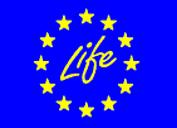

TECHNICAL FINAL REPORT 2007
LIFE 2003 NAT / RO / 000027 / REV
Restoration Forest habitats from Pietrosul rodnei biosphere reserve
Project Author and Manager
Dr. Ioan BLADA
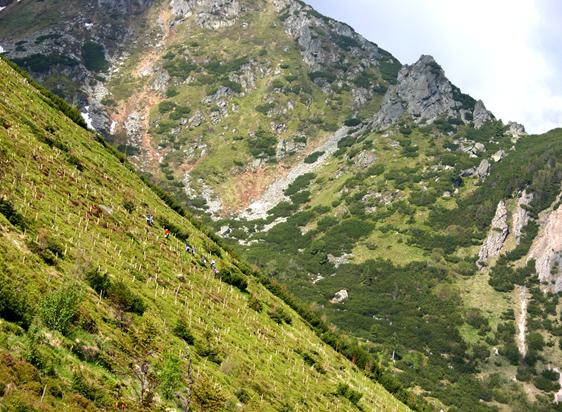
Bucharest 2007

LIFE Project Number
LIFE 2003 NAT / RO / 000027 / REV
TECHNICAL FINAL REPORT
Covering the project activities from 01.01.004 to 01.06.007
Reporting Date: 30.08.2007
LIFE PROJECT NAME
Restoration Forest habitats from Pietrosul rodnei biosphere reserve
Data Project
Project location |
Pietrosul Rodnei Mountain, Borsa Forest District |
Project start day |
01.01.2004 |
Project end day |
01.06.2007 |
Total Project duration |
41 months |
Total budget |
213 470 € |
EC contribution |
106 735 € |
(%) of total costs |
50 |
(%) of eligible costs |
|
Data Beneficiary |
|
Name Beneficiary |
Forest Research and Management Institute |
Contact person |
Mr. Ioan Blada |
Postal address |
Sos. Stefanesti no. 128, 72904 Bucharest , Office 11, Sector 2 |
Visit address |
Sos. Stefanesti no. 128, 72904, Bucharest , Office 11, Sector 2 |
Telephone |
+4 021 350 32 45 |
Fax: |
+4 021 350 32 45 |
icas@icas.ro |
|
Project Website |
www.icassv.ro/life_pietrosu/ and www.icas.ro |
3. SUMMARY (English)
It is important to stress that after the project starting, on 46 399 ha area, the Rodnei Mountains National Park was created and the initial Pietrosul Rodnei Biosphere Reserve, including the project area, became components of that Park.
The present report covers all the tasks and results obtained during the project implementation in the Pietrosul Rodnei Biosphere Reserve (PRBR) including Pietrosul Mountain .
The Project objectives were: (a) r e-introduction of P. cembra species and restoration of P. cembra / P. mugo / Picea abies natural habitat on 50 ha from Zanoaga hollow of the PRBR and (b) conservation of all flora and fauna habitats on 6 415 ha including P. cembra / P. mugo / Picea abies one from PRBR .
By using a small amount of currency, the project has solved some important ecological problems that occur in Pietrosul Mountain . Perhaps the reintroduction of the P. cembra species on 50 ha and restoration of P. cembra / P. mugo / Picea abies habitat represent the major action that was fulfilled during the project implementation. Firstly, by planting area, the cembra pine will be recovered and the population from the Pietrosul escapes from extinction. The encountered difficulties concerning seedlings transportation from Borsa to Pietrosul and followed by plantation in difficult mountainous conditions represented the main subject of the first film Then in the last decades, the flora and fauna habitats were significantly degraded, so that urgent protection and conservation measures had to be taken. For this reason, a long term conservation management plan was conceived and implemented. Owing to the above mentioned implemented plan, the flora and fauna species and all habitats not only from PRBR ( 6415 ha ) but also from the whole MRNP ( 46399 ha ) will have better conditions for life than in the past. Additionally, significant scientific contributions were achieved. So, full inventories of herbaceous, woody, mammals, birds, fishes, amphibians, and reptile species were made. Connected to the flora, a second video-film was produced and displayed in many institutions, as public awareness. By for a determination, Dr. Gh. Coldea significantly contributed to this film. Also, in the frame of public awareness, 4000 brochures and 2000 leaflets were produced and widely distributed.
All achieved results can be visited on the project website.
List of key deliverables and outputs
Effective re-introduction by planting P. cembra species and restoration of P. cembra / P.mugo / P. abies habitat on 50 ha from Pietrosul;
Long-term Conservation Management Plan for the whole RMNP;
Implementation of Long-term Conservation Management Plan by integrating the best measures for conservation of all flora and fauna habitats across the RMNP;
Construction of 10 information panels and their installation in key places;
Scientific inventory of herbaceous species from PRBR;
Scientific inventory of bird and mammals from PRBR;
Scientific inventory of tree and shrub woody species from PRBR;
Scientific draft concerning distribution and structure of the P. cembra / P.mugo / P. abies habitat from PRBR;
GIS distribution map of the flora and rocky ecosystems / habitats, from PRBR;
Refugee chalet and toilet cabin in the chalet area;
A draft showing the evolutionary process of P. cembra species re-introduction and of P. cembra / P. mugo / P. abies habitat restoration in the project area;
Project Website;
4 000 printed brochures and 2 000 leaflets;
Layman's report;
Two video documentary films;
Three progress reports and one final technical and financial report.
The After-LIFE Conservation Plan.
3. REZUMAT (Summary Romanian version)
Este important de subliniat faptul ca, dupa inceperea proiectului, pe o suprafata de 46 399 ha , a fost infiintat Parcul National Muntii Rodnei care include Rezervatia Biosferei Pietrosul Rodnei, precum si suprafata din proiect.
Prezentul raport cuprinde toate sarcinile prevazute si rezultatele obtinute in timpul implementarii proiectului in Rezervatia Biosferei Pietrosul Rodnei (PRBR), inclusiv in Muntele Pietrosul.
Obiectivele majore ale proiectului au fost: ( a) r eintroducerea speciei P. cembra si refacerea habitatului natural de P. cembra / P. mugo / Picea abies pe 50 ha din depresiunea Zanoaga si (b) conservarea tuturor habitatelor de flora si fauna pe o suprafata de 6 415 ha , inclusiv a P. cembra / P. mugo / Picea abies .
Cu ajutorul unor fonduri mici, proiectul a rezolvat importante probleme silvo-ecologice din Muntele Pietrosul. Poate ca reintroducerea yâmbrului pe 50 ha asociata cu refacerea habitatului P. cembra / P. mugo / Picea abies actiunea majora rezolvata prin implementarea proiectului. Aceasta, în primul rând, pentru ca prin aceasta plantare, zâmbrul se va regenera natural, scapând de pericolul disparitiei lui din Pietrosul. Dificultatile întâmpinate în timpul transportului puietilor de la Borsa la Pietrosul precum si greutatile legate de pichetarea terenului, pregatirea vetrelor, caratul puietilor cu cosul pe spate, caratul pamântului de împrumut si plantatul constituie subiectul primului film realizat în cadrul proiectului.
Apoi se pune problema protejarii habitatelor întrucât în ultimele decenii flora si fauna au fost degradate semnificativ fapt care impune luarea unor masuri urgente de conservare. În acest sens, colectivul Parcului National Muntii Rodnei a conceput si implementat planul de management iar implementarea lui contribuie la crearea unor conditii mai bune de dezvoltare a florei si faunei mai bune decât în trecut, nu numai din Rezervatia Biosferei ( 6415 ha ) ci din întrgul Parc National ( 46399 ha ). În plus, prin realizarea inventarului florei ierbacee si lemnoase, a pasarilor si mamiferelor, a pestilor, amfibienilor si reptilelor, au fost aduse importante contributii stiintifice. A ost realizat si difuzat în scopul popularizarii si filmul al doilea care prezinta o parte din flora Pietrosului, film la care, prin determinarea speciilor, a contribuit si Dr. Gh. Coldea. Tot în cadrul constientizarii publicului aau fost realizate si diseminate 4000 brosuri si 2000 pliante.
Toate realizarile proiectului LIFE-Natura Pietrosul pot fi vizitate pe internet la adresa: www.icassv.ro/life _ pietrosu/
Lista celor mai importante actiuni rezolvate
Reintroducerea efectiva prin plantare a speciei P. cembra si refacerea habitatului de P. cembra / P.mugo / P. abies pe 50 ha din Pietrosul;
Planul de management pentru toata suprafata Parcului National Muntii Rodnei;
Implementarea pe termen lung a planului de management privind conservarea prin cele mai adecvate masuri a florei si faunei pe toata suprafata Parcului National Muntii Rodnei;
Confectionarea a 10 panouri informative si amplasarea lor in punctele importante din zona de implementare a proiectului;
Inventarul stiintific al speciilor ierbacee din Rezervatia Biosferei Pietrosul Rodnei;
Inventarul stiintific al speciilor de pasari si mamifere din Rezervatia Biosferei Pietrosul Rodnei;
Inventarul stiintific al speciilor de arbori si arbusti din Rezervatia Biosferei Pietrosul Rodnei;
Raportul stiintific privind structura si distributia habitatelor de P. cembra / P.mugo / P. abies din Rezervatia Biosferei Pietrosul Rodnei;
Intocmirea prin mijloace GIS a hartii cu ecosistemele vegetale si stancariile din din PRBR;
Refacerea cabanei pentru muncitori si personalul tehnis precum si a toaletei din zona cabanei;
Intocmirea unui raport care oglindeste procesul evolutiv privind reintroducerea speciei P. cembra si refacerea habitatului de P. cembra / P. mugo / P. abies pe suprafata proiectului;
Deschiderea unui site pe internet al proiectului;
Intocmirrea, tiparirea si diseminarea a 4 000 brosuri si 2 000 de pliante;
Intocmirea unui raport de popularizare a rezultatelor carese adreseaza marelui public (Layman,s Report);;
Producerea si difuzrea a doua filme documentare;
Intocmirea a trei rapoarte tehnice ;i financiare anuale si a celor finale.
Intocmirea unui plan cu actiunile de conservare si populariyare ce se desf[soara dupa incheerea proiectului.
4 Introduction
Description of the background, problem and objectives
Overall objectives
Reintroducerea speciei P. cembra si refacerea habitatului natural de P. cembra / P. mugo / Picea abies pe 50 ha din depresiunea Zanoaga;
Conservarea tuturor habitatelor de flora si fauna pe o suprafata de 6 415 ha , inclusiv a P. cembra / P. mugo / Picea abies ;
The site involved
The project was implemented in the Pietrosul Rodnei Mountain, specifically in the Zanoaga Mare hallow and its addiacent area, located between 1600 m and 1950 m elevation
Habitat types
As a European heritage, the PRBR is one of the nine units of the RMNP . Inside PRBR , which includes the 50 ha project area, forests, alpine meadows, birds, carnivores and rocky areas occur.
According to the Bern convention resolution n° 4 (1996), the following directly targeted habitat types occur in the Pietrosul Mountain and project area, as well:
4070 Bushes with Pinus mugo and Rhododendron hirsutum
9410 Acidophilous Picea abies forests of the montane to alpine levels
9420 Alpine Pinus cembra forests
The species inserted in the directly targeted habitats directive annex II are: * Ursus arctos, *Canis lupus and * Cypripedium calceolus.
The directly targeted species according to the Bern convention resolution present in the project area are: * Aquila heliaca, * Aquila clanga , and * Aquila pomarina
Threats in the Pietrosul zone
For P. cembra the main threat consists in genetic erosion and possible extinction of population because only a few very old trees, unable to produce seed for regeneration, remained in Pietrosul
At the same time, most of the P. abies and P. mugo trees from the alpine and sub-alpine zone were cut by the local people and shepherds to create meadows for grazing or to be used for industrial and domestic reasons or as fire wood. P. mugo was cut for turpentine extractions while the P. abies mainly for housing. As result, a strong degradation of P. cembra / P. mugo / P. abies natural habitat from Pietrosul took place.
Another threat consists in not enough sustainable conservation activities of flora and fauna habitats. S hepherds and local people and the tourists used to collect wild flowers, to disturbing or even killing fauna. All previously mentioned factors contributed to degradation of both flora and fauna habitats. The grazing represents another destructive factor for flora and Consequently urgent protection and conservation measures have to be taken.


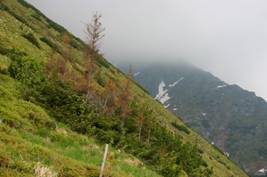
(1) The old c embra pine population g o to extinction (2) Highly degraded habitat where the cembra and dwarf pines was cut
Main restoration and conservation issues being targeted
In order to restoration and conservation of the threatened species and habitats several actions have to be taken, such as:
species / habitat restoration where possible;
guarding the MRNP, PRBR in order to limitation of the destructive actions of the tourists, local people, domestic animals, shepherds;
limitation tourist access to the area with rare flora, where the birds nesting;
shooting the stray dogs in order to prote4ct the wildlife;
grazing interdiction;
to control and prohibiting the illegally hunting.
How did the project come about
By project implementation, the P. cembra species was reintroced in the Zanoaga Hollow and the P. cembra / P. mugo / P. abies habitat as restored;
According to the implemented management plan, all necessary measures were taken to improve conservation of flora and fauna.
Expected results
For woody species, in case of the LIFE Pietrosul implemented project, the following results are expected
On immediate term:
Re-introduced, on genetic and ecological principles, of P. cembra species and restored P. cembra / P.mugo / P. abies habitats on 50 ha ;
On medium term:
Creation of better conditions of life for herbaceous flora and wildlife followed by a normal future development; Preventing soil erosion and flooding;
On long term:
Creation (after about 20 years, when P. cembra trees blossoming) of normal inter-pollination among the new generation of trees and, consequently, the natural regeneration process restarts. Then, from Zanoaganucleus, the species extends little by little to the surrounding areas.
Preventing avalanche formation.
In case of habitats protection and conservation, it is expected that, as foreseen in the management plan, all flora and fauna not only from the PRBR and LIFE area but from entire MRNP will be well protected and conserved; the guarding team together with the Borsa forestry gendarmerie proved that their common actions are very efficient.
5. LIFE-PROJECT FRAME WORK
Description and presentation of working method is specific for each action and sub-action and it will be presented in detail at the point 6.
The beneficiary, i.e. the Forest Research Institute is a state organization dealing with various research fields, such as: silviculture, genetics, dendrology, entomology, ecology, biology, topography, Biometry, dendrochronology, pedology, wild life, forest management, botany. The acquired practical results are usually implemented by the Romsilva National Administration. The Institute consists in its headquarter and 11 regional research stations. The financial support is obtained through national and international projects and through its production sector. A total of 280 employee of which 120 researcher or forest engineers involved in research.
The forest State Administration of the Maramures County (FSAM) is the project partner but the financial support was supplied by the Borsa Forest District which is its subunit. The FSAM administrate 15 forest districts
A request for project modification budget was sent to the EC on early 2005 and approval of the ENV D1/FV was issued on August 31, 2005 under the no. 16882. The major request consisted in transferring currency from Personnel, from travel and from consumable to the External Assistance. Details concerning amount transferred and about reasons why were presented in our request. All transfers were made within the frame of the same initially approved project amount.
6. RESULTS
The acquired results are presented for each action / sub-action, separately, according to the foreseen tasks.
Action A.1:
Assessment of the woody, herbaceous and rocky ecosystems / habitats from Pietrosul Rodnei Biosphere Reserve ( 6415 ha ) based on both GIS high-resolution satellite imagery and field survey.
Expected results: Making an exact inventory of P. cembra remaining trees, assessing the structure, distribution and degradation level of P. cembra habitat, produce inventory of tree, shrub and herbaceous plants; inventory of birds, and mammals. There will be produced the habitat map of the Biosphere Reserve and formulated proposals for re-introduction, restoration and conservation..
Achieved results
Digital distribution map of the flora and rocky ecosystems / habitats, including P. cembra / P .mugo / P. abies ones
There was obtained the distribution map of flora and rocky habitats with its associated geographic components at 1:5000 scale. The GIS and remote sensing team, using his specific equipment (with the project financial support), fulfilled this work. The digital map was based on Quick-Bird satellite imagery, taken on July 10, 2004 , with spatial resolution at 0.6 m of the panchromatic band and 2.4 m multi-spectral. The resulted spatial Map.1 shows the woody and herbaceous and rocky ecosystems / habitats. The next operation was a field check of the visual image interpretation and georefernced accuracy evaluation.
Final operation was the on-the-screen vectorization of the main limits of the flora and rocky ecosystems / habitats and encoding of each type of land cover. The result is a land cover layer as shape file (Arc View) containing accurate geographic information that could be up-dated and combined with others geographic information, usable to build different maps and for spatial analyze (Maps 1 and 2) . Due to its very high spatial resolution, the maps allow to be seen the natural ecosystems.
The maps were delivered to EC in 2004 with the Progress Report 1.
It should be stressed that the two maps, which will be insert on our webpage, represents a premiere for the Pietrosul Rodnei Biosphere Reserve and for any other similar forestry unit from Romania .
Details concerning techniques of re-introduction and restoration by planting was prepared in A 2 and performed in C 1 while the conservation was proposed in A 3.
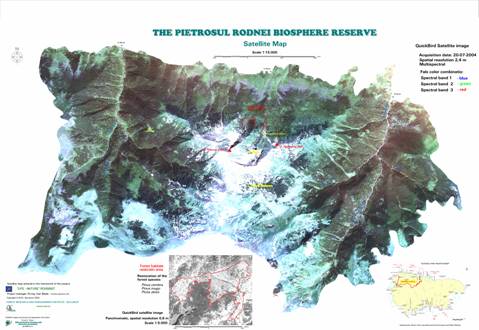
Map 1. Digital distribution map of the Pietrosul Rodnei Biosphere Reserve
showing where the project site is places
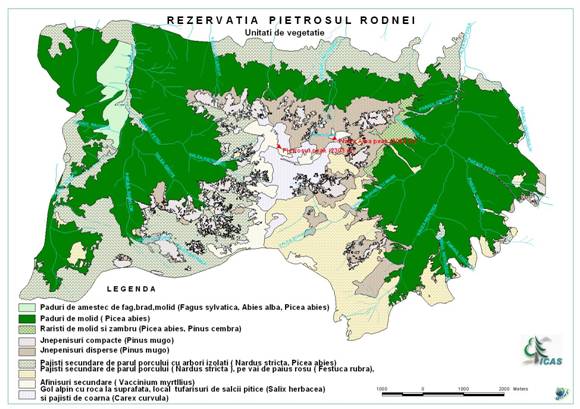
Map 2. Digital distribution map of the Pietrosul Rodnei Biosphere Reserve
Showing the natural ecosystems
Scientific inventory of herbaceous species (A.1)
Across the Pietrosul Rodnei Biosphere Reserve, a comprehensive inventory of the herbaceous species was made and it was already included in the Project webpage. This inventory showed that the Biosphere Reserve is extremely rich in species, and the following botanical characteristics are highlighted here:
a number of 568 herbaceous species distributed within 58 families, were found;
the Asteraceae and Poaceae families with 98 and 54 species, respectively, were the richest ones, while 13 families have only one species, each one;
most species were recorded on alpine and sub-alpine pasturelands but the herbaceous flora found under the forest canopy was, poorer mainly in conifer forests;
for Romania, there were found 22 endemic species, 18 rare species, seven protected species and nine protected and included in the Red List species ( Annex 1, Table 1 ) ;
a number of seven threatened species at European level included in the IUCN List were found in the Pietrosul Rodnei Biosphere Reserve ( Annex 1, Table 1 );
Results of this inventory were delivered to the EC in 2004 with the Progress Report 1.
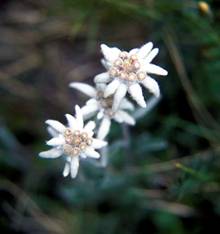
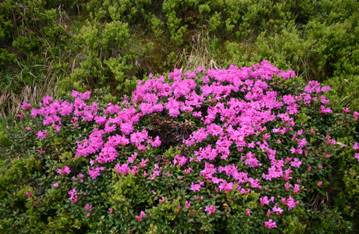
Leontopodium alpinum -------------------------------------Rhododendron myrtifolium


Primula minima ------------------------------------Rhodiola rosae
Scientific inventory of tree and shrub woody species
Comparing with herbaceous species, as expected, the number of woody species was much smaller. There were found 57 species, of which 14 trees, 26 shrubs and 17 sub-shrub species ( Annex 1, Table 6)
. The following aspects should be stressed:
P. cembra, P. mugo, P. abies, Sorbus aucuparia , and Alnus viridis are the most important woody species within the Pietrosul LIFE project area;
P. mugo habitat is included in the Annex I of the Habitat Types, Code 4070.
Picea abies and Pinus cembra are components of habitat type according to the Habitats Directives, Code 9410 and 9420, respectively;
Pinus cembra and P. mugo are included in the Romania Protected Species List (Annex 1, Table 1 ).
Concerning P. cembra , it should be stress that on the Pietrosul, a large population was growing in the past but now, the number of remained old trees is less than 40 and most of them are very old and highly dispersed or even isolated each other so that the inter-pollination is restricted while the self-pollination is the rule. Only three young trees naturally regenerated were found. This demonstrates that the heavy infusion, via LIFE project, with new planted P. cembra seedlings will prevent the extinction of the species population from Pietrosul.
It is significant to note that during our investigations on the subalpine zone, within the project area, just in the Zanoaga Mare Hollow a (perhaps) new two needle dwarf pine form or variety unlike P. mugo was found. This atypical form is now testing including through genetic means.
Results of the inventory were delivered to the EC in 2004 with the Progress Report 1.
Scientific draft concerning distribution and structure of the P. cembra / P.mugo / P. abies habitat in Pietrosul Rodnei Biosphere Reserve
In order to get details about the distribution and structure of the woody species habitats, during the vegetation season of the 2005 year a comprehensive survey all over the Pietrosul Rodnei Biosphere Reserve was done. The survey focused on each of the three altitudinal levels of vegetation currently recognized, such as:
mountainous level with two sub-levels
average sub-level between 740 and 1100 m elevation;
high mountainous sub-level between 1100- 1500 m elevation;
sub-alpine level between 1500 and 1900 m elevation;
alpine level between 1900 and 2003 m elevation.
The mountainous level with its average sub-level between is characterized by the occurrence of the beech ( Fagus sylvatica ) and spruce ( Picea abies ) forests where Acer pseudoplatanus, Sorbus aucuparia and Betula pendula scattered trees can vegetate.
S ub-alpine level is characterized by the occurrence of the scattered or in groups, the following woody species: P.mugo, Pinus cembra, Juniperus sibirica and Rhodendron myrtifolium .
In its composition, the alpine level has small trees or bushes of Salix reticulata and Vaccinium gaultherioides.
It should be stressed that survey took into account not only woody vegetation but all environmental conditions in which it develops, such as: geology, geomorphology, hydrographic factors, soil,
The results of the inventory were delivered to the EC in 2004 with the Progress Report 1.

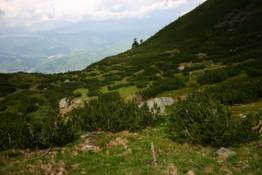
Picea abies, Pinus cembra and Pinus mugo associated species
Scientific inventory of bird species
A very detailed inventory of the birds was made by a specialist in ornithology from outside of our Institute. Because the Institute has no an ornithologist, this work was sub-contracted.
Over Pietrosul Rodnei Biosphere Reserve, a total of 86 bird species distributed at 58 genera, 28 families and nine orders were recorded ( Annex 1, Table 2 )
With its 18 families and 53 species, the Passeriformes order is the largest while the Cuculiformes order with only one family and one species, is the smallest one;
The Turdidae family with its 10 species is placed in the top of the rank;
Of 86 bird species, 87 % are nesting within the Biosphere Reserve while 13 % are passengers;
Again, of 86 bird species, 10 are present on the Romanian Red List, while only one ( Aquila clanga ) can be found on the European one ( Annex 1, Table 3 )

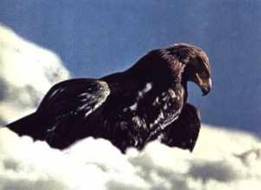
Tetrao. urogalus Aquila chrysaëtos
Scientific inventory of mammal species (A.1)
The Mammals inventory has the following composition ( Annex 1 , Table 4):
Forty one species distributed in six orders and 17 families;
According to the Romanian law 462 / 2001, six species require strict protection and they are included in the Red List, such as: Canis lupus, Lynx lynx, Neomys anomalus, Sicista betulina, Sorex alpinus and Ursus arctos ;
The following species listed in the European Red List are living in the Biosphere Reserve, as follows: Lynx lynx, Ursus arctos Canis lupus, Felis silvestris.
Table 4 shows that the Mammals Red List for the Pietrosul Rodnei Biosphere Reserve (which is valid for Rodnei Mountains National Park , as well) includes many in danger species, Ursus arctos and Canis lupus among them. Though, it is not present in this Red List, the black goat ( Rupicapra rupicapra )
from Pietrosul used to be considered in danger species because of the past illegal hunting. Due to the guard team of the Park, the situation was significantly improved.
The results of both birds and mammals inventories were delivered to EC in summary with Progress Report 1 and full lists with interim report.
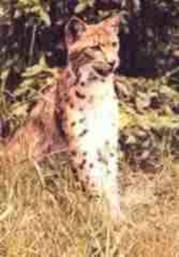

Lynx lynx ---------------Rupicapra rupicapra
Besides the planned inventories at Action A1, it was performed also inventory of three taxonomic groups of fauna, i.e. Fishes, Amphibians and Reptiles ( Annex 1, Tab. 5) . These inventories were not foreseen in the project.
Durable goods purchased from Action A.1
The following durable goods were purchased: GIS software upgrade; hardware upgrade; digital camera; Quick Bird satellite imagery and a mobile phone. Initially, this mobile phone was missed to be included on the list; however, because it was necessary for project implementation, it was purchased and included at this item. . These durable goods have been currently used for implementation of the project specific actions.
It is recognized that without the above mentioned equipment, some project actions could not be solved.
Since the beginning, all durable goods were included in the ICAS inventory and their utilization after project termination, is as follows:
digital camera will be used by project manager and his team for taking pictures within the project area according to The after LIFE-Conservation Plan ( Annex 2, point 5 and 6 )
GIS software, hardware upgrade and Quick Bird satellite imagery will be used by the ICAS GIS team.
Action A.2:
Preparation of the technical management plan aiming at P. cembra species re-introduction and P. cembra / P.mugo / P. abies habitat restoration
Expected results: a technical plan aiming at habitat restoration
Achieved results :
A technical management plan was conceived, comprising step by step all activities aiming at P. cembra species re-introduction and P. cembra / P.mugo / P. abies habitat restoration on 50 ha . This plan was made and already applied as a guide during the last three years in order to ensure the success of Pinus cembra p. mugo and Picea abies re-introduction by planting as specified at the Action C.1. This project comprises all actives connected with the objective to be reached, such as: seed origin, seed collection and processing, nursery techniques, planting technique, etc and all concerned costs.
The summary was provided to the EC in the Progress Report 1 in 2004 and the complete technical management plan is sent to the EC together with the Final report.
Action A.3:
Long-term Conservation Management Plan to enforce sustainable activities of all flora and fauna habitats from Pietrosul Rodnei Biosphere Reserve
Expected results
A comprehensive long-term conservation management plan for all flora and fauna habitats from Pietrosul Rodnei Biosphere Reserve will be prepared. In the meantime, the Rodnei Mountains National Park was established so that the management plan was extend to it. Based on this Draft, the Life project actions will be continuing, so that, long-term conservation of all flora and fauna habitats, including P. cembra / P. mugo /P. abies one will be achieved. This plan has to be accepted by all factors involved but mainly by the new created Scientific Committee of the Park.
Achieved results
The Pietrosul Rodnei National Park did not exist in the year 2002 when the LIFE-Nature Application Forms were prepared. As this state institution was created in the 2004 year and the Pietrosul Rodnei Biosphere Reserve was included within it. For this reason the elaboration of Management Plan was foreseen in the project application for the Pietrosul Rodnei Biosphere Reserve including the Pietrosul new habitat created through the LIFE-Nature Project. The Management Plan was conceived and sent to the EC with Progress Report 3 on December 2006.
Taking into account the inclusion of the Biosphere Reserve and project area inside of National Park, the present management plan was extended to the whole National Park with specific references to the LIFE Pietrosul project area.
The management plan includes actions to be taken during life project and established working framework for long-term conservation and management for the whole National Park. Furthermore, the plan integrates the economic and conservation activities in a holistic concept for sustainable development of the area in question with special emphasis to specific actions regarding woody habitats restoration and conservation of all flora and fauna. In course of the management plan preparation, three workshops (preparatory, intermediary and final) were organized as part of consultation process with local administration, stakeholders and some local people, members of the Commission of the Nature Monuments, staff of Scientific Council of the National Park and members of Life project. These preparatory processes were moderated by the Scientific Committee of the Park that finally approved the plan. The three preparatory processes took place, such as: 11.12.2005, 13.02.2006 and 25.04.2007.
It should be stressed that alongside the foreseen management actions concerning the National Park, specific protection and conservation measures for project plantation were inserted in the management plan. Based on this plan, the Life project actions will continue, so that, long-term conservation of all flora and fauna habitats, including P. cembra / P. mugo /P. abies one will be achieved. Finally, the Management Plan of the Pietrosul Rodnei National Park including Pietrosul Rodnei Biosphere Reserve and the LIFE-Project area was endorsed by the Scientific Committee and by the National Park Committee through an official document registered under the number 43 / June 9, 2006 at the National Park headquarter.
The Management Plan was submitted to the EC on December 2006 with the Progress Report 3.
Action A.4:
Set up the Advisory Board and Management Project Team
Expected results: Set up the Advisory Board and Management Project Team
Achieved results
To ensure the correct implementation of the project, on January 2004, the A dvisory Board and Management Project Team were set up.
The Advisory Board consists of 8 members and includes representatives of the local authorities of the economic and cultural institutions, forest administrators, ROSILVA and National Park and Academy representatives ( Annex 3, Table 1 ). The main task of this Advisory Board is to ensure the project implementation, acting as a working framework. The board has had one meeting (but not two as foreseen) yearly where the project manager, presented the achieved results followed by discussions. It was not necessary to have two meetings per year.
The Management Project Team consists of 18 members and it is composed of scientists, forest engineer and technicians whom background is connected with the aim of the project ( Annex 3, Table 2 ). The status of the project implementation was reported to the Advisory Board.
Action C.1:
Effective re-introduction of P. cembra and restoration of P. cembra / P.mugo / P. abies habitat by planting in the Zanoaga hollow from the Pietrosul Rodnei Biosphere Reserve
Expected results: sticks preparation, Seedling beds marking by sticks on the planting land, seedling bed or site preparation, seedling origin and their production, seedlings transport, seedlings distribution to the seedling beds, and planting site, planting design and effective plantation.
Achieved results
Sticks preparation
A number of 12 350 conifer wood sticks were prepared to be used for land picketing. The stick dimensions were 100 cm long, 5 cm wide and 3 cm thick.
Seedling beds marking by sticks on the planting land
This was the first field operation aiming at marking the place where the seedling bed has to be prepared . To be visible from distance, in the years 2004, 2005 and 2006 each of the 12350 seedling beds covering 50 ha were marked by prepared sticks. The sticks helped the worker to locate the place where the seedling bed has to be prepared. It should be stress that on the area with avalanche occurrence, the sticks, i.e. the plantation density was much higher than in any other part of the project area. This is because a higher density of trees will be more efficient against the avalanche initiation.

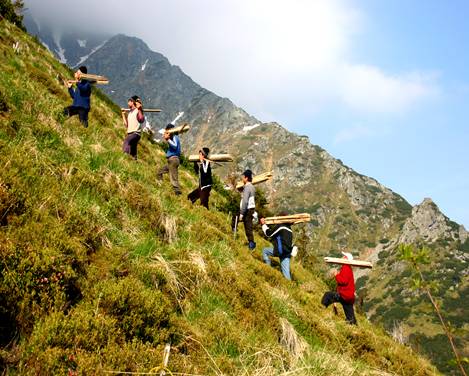
Photo: Sticks transportation on the back and seedling beds marking on the field
Seedling bed or site preparation
The operation of hoeing of the seedling bed took place, immediately after the land was marked by sticks, i. e. mid June of the years 2004, 2005 and 2006. The seedling bed dimensions were of 80 cm x 80 cm a 20 cm depth. Because of the extremely harsh environment conditions (compact and/or lack of soil, dense Vaccinium sp. and herbaceous layer, stony ground, presence of bushes, etc.), this operation was made by the mountain special hoe. According to the site conditions, two kinds of tools were used, such as: the hoe when the soil was rock less and crowbar when the seedling bed substratum consisted more of stones than soil. By this way, a total of 12350 seedling beds were prepared. Seedling bad preparation at the beginning of the vegetation season is much easier than at the end of August when plantation takes place. This is because the weeds and grasses and the sub-shrubs like Vaccinium, Rhododendron, etc. have stronger roots than in the spring. In addition, the soil on the seedling beds accumulates moisture and became more suitable for plantation activity.
The marked position of seedling beds on the field and site preparation. The shown is the area where the avalanches occurred and the sticks / trees density is higher than elsewhere


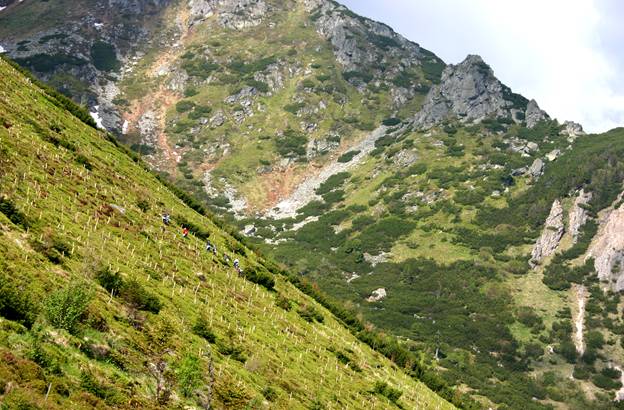
Seedling beds preparation
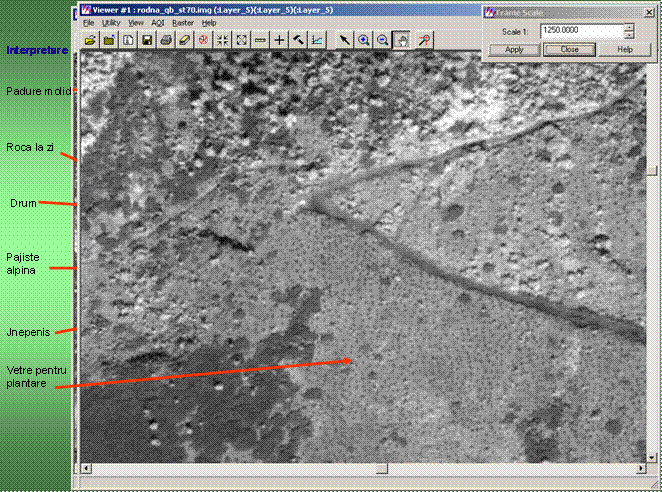
Map 3. Quick Bird Satellite Imagery taken on July 10, 2004 : the seedling beds of 80 x 80 cm size can be seen from satellite ( 0.6 m resolution)
Seedling origin and their production
The P. cembra reintroduction and restoration of P. cembra / P.mugo / P. abies habitats was conceived to be made according to the genetic and ecological requirements. For this reason, P. cembra seedlings originate in the natural population Lala Valey near the Inau Mountain , a massive included, as Pietrosul, in the same Rodnei Mountains range. Therefore, the Lala Valey population has the same genetic structure and ecological requirements as that from Pietrosul Mt. where the project area is placed. Prior to launch the Project, these seedlings were already produced in the Sinaia Nursery belonging to the Bucharest Forest Research and Management Institute. The seedlings were grown in individual plastic bags fill in with acidophilus spruce humus. At the planting moment some of seedlings were seven to nine years old and they were very well developed and health (See the nursery picture). Each seedling including potted soil has weight between 4- 6 kg . Using potted seedlings ensures the planting success.
Picea abies and Pinus mugo seedlings have their origin in the Pietrosul Mountain natural population, i. e. very close to the project area.
To anticipate an answer to the question why not the Pietrosul P. cembra provenance was used for its population restoration, the following answer is given: just because, as earlier stated, the Pietrosul natural population is very close to extinction and the resulted seed / seedlings are from self / pollination and such seedlings / tree have very low survivals.
All the seedlings were produced by the ICAS as beneficiary / partner at its Sinaia Nursery located at about 700 m elevation. As mentioned in the Application Forms, the cost of the seedlings represents almost the entire Beneficiary's co-financing. It should be stressed that, except ICAS, no other company is producing P. cembra and P. mugo seedlings.
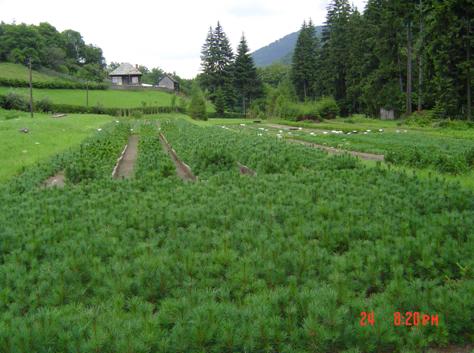
The ICAS Nursery from Sinaia where the seedlings were bred
. 

The ICAS Nursery with P. cembra and P. mugo seedlings.
Seedlings transport
The seedling transportation took place from Sinaia Nursery to Borsa and then up to Pietrosul Mt. proved to be a very difficult task because:
the seedlings were grown in plastic pots filled in with soil and for this reason, they could not be overlap during transportation;
the Sinaia Nursery is placed in a hollow and because of this, the seedling transportation to the accessible road for trailer had to be made by a cart pulled by a horse from 600 to 750 m elevation;
then the seedlings were loaded in big trailers and transported about 650 km to the Borsa down town;
then the seedlings were transferred on four powerful lorries and transported seven km to the Borsa outskirts placed at 700 m elevation where the seedlings were unloaded;
then the seedlings were transported to the mountain planting site at about 1700 / 1800 m elevation; only a caterpillar tractor could make this transport on a very bad and sloppy primitive road, (See photo); only 300 seedlings could be taken on each drive / transport and two drives a day; 20 transport / days; a number of 20 days were necessary for 12 350 seedlings transportation from Borsa outskirts intermediate deposit to the Pietrosul Mt.

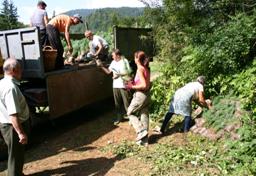
From Sinaia Nursery to the access road From Sinaia Nursery access road to Borsa outskirts
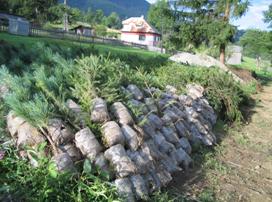
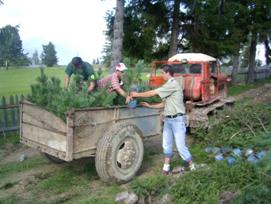
Intermediate deposit at Borsa outskirts From Borsa outskirts to Pietrosul at 1700 m a.s.l.
Seedlings distribution to the seedling beds
By using wood baskets, the 12350 potted seedlings were carried by the workers (on their back) to the planting beds distributed all over 50 hectares . Because of the basket weight (about 30 kg ) and sloppy land and wild vegetation, this work was very hard and difficult. For transportation 12350 potted seedlings, about 400 up and down runs took place.
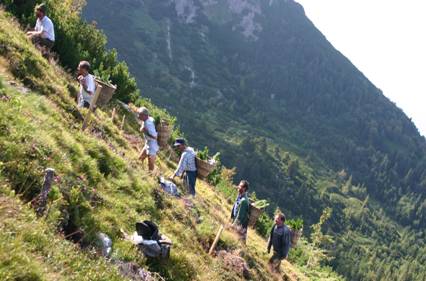
On the back by baskets transportation seedlings to the seedling beds

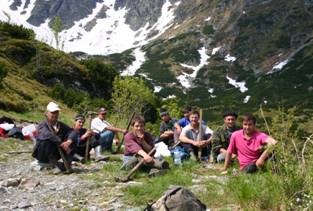
The working team rests after a hard working day
B orrowed soil transport
On some parts of the planting area, about 1000 seed bed required borrowed soil. This soil was transported by the caterpillar tractor from 800 m elevation outside Biosphere Reserve, to about 1700 m elevation where it was deposited. From that place, using wood baskets, the workers carried the soil on their back to the soil-less seedling beds. It was a hard work.
Pl anting site, p l anting design and plantation
The planted area is laying out on the northern slope of Pietrosul Mt. between 1600- 1990 m elevations, namely across the Zanoaga Mare and Piciorul Mosului .
The initial foreseen planting design. Because an ecological plantation was assumed to be made, the tree too tree distance varied between 2 to 20 m , i. e. a 10 x 10 m average distance was taken into account. The intention was to restore the past local landscape, if possible. For this reason, an irregular planting framework was adopted. It is well known that P. cembra and P. abies trees are "tall" species while the P. mugo is a dwarf bush trees. Therefore, the 5000 P. mugo seedlings were planted (over the same 50 hectares ), at irregular distance, among the other two tree species. In other words, it was not taken into account at the area calculation. This infusion with P. mugo will speed up restoration of the above ground carpet which soon contributes to the soil protection.
The real applied planting design: Taking into account the newly acquired information about the planting area, the initial plan was slightly improved. It was learned that after previous trees cutting, the Piciorul Mosului steep slope became a place with avalanche occurrence. Two avalanches occurred on winters of 2005 and 2006 when five people were killed. Consequently, in order to prevent the avalanche initiation it was decided to increase the plantation density by planting 5550 seedlings (2 350 P. cembra and 3 200 Sorbus aucuparia local provenance) in addition, so that on the same 50 hectares , altogether, 15550 instead 10000 seedlings were planted. Sorbus aucuparia is naturally spread all over the Pietrosul sub-alpine ecosystem where at its early age it growth faster than any other local species and in addition resistant
to harsh climatic conditions. It is expected that at least for the long term, this mixed population will play a positive role in avalanche control. It should be stressed that in the first version of the Application forms of this LIFE project, S. aucuparia was proposed to be included in the P. cembra / P. mugo / P. abies habitat but the proposal was rejected during the Application revision at European Commission level. This species can not be missed from Pietrosul sub-alpine habitats / ecosystem.
The plantation was made in late August of the 2004, 2005 and 2006 years, consecutively. Plantation hole was of 30 x 30 cm deep and placed in the centre of the seedling bed. Each seedling of P. cembra and P. abies was planted separately in its whole while P. mugo and S. aucuparia seedlings were planted together in the same whole. In the sub-alpine zone, at early age, the S. aucuparia grows much faster than any other woody tree species, so that the taller and denser the trees the most efficient against avalanche initiation. This is another reason why the S. aucuparia was planted on the avalanche track. Because the S. aucuparia is a principal component of the Pietrosul Mountain flora, this is another reason why it was used for plantation. It should note that all 10000 seedlings foreseen initially were grown in plastic bags and planted bag less; this working procedure ensure a high level of surviving or success. The other 5550 seedlings (2350 P. cembra and 3200 S aucuparia ), planted in addition, were planted with bare roots so that some losses are expected. Both the cost and the work for planting of these 5550 seedlings were not charged to the project.
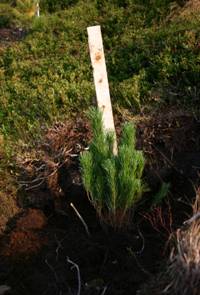
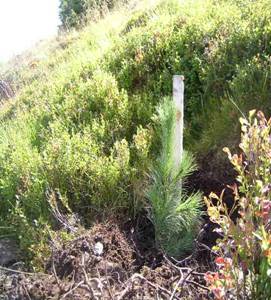
After planting: P. mugo P. cembra

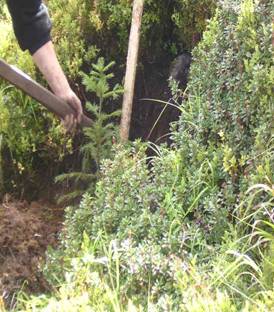
After planting: P. abies
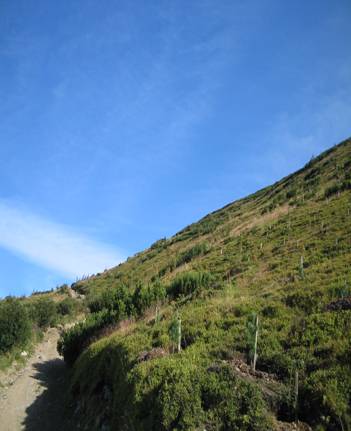
A sample of planted area
Action C.2:
Construction of refugee chalet and a toilet
Expected results:
One refugee chalet and one toilet cabin, both of wood build up inside Zanoaga hollow, i. e. inside project area.
Achieved results
In order to sheltering scientists and technicians and workers during the project implementation and rangers during Management Plan implementation, a refugee chalet was built alongside the LIFE-Nature project area.. Initially, a one room chalet was planned but finally a two room chalet including an attic was built. The conifer wood was used as basic material for construction of all components such as: infrastructure, walls, roof of shingle, doors and windows. For the protection of indoor against cold a Rigip isolation layer was placed on the inside face of the walls. For a better outdoor protection against moisture, the external walls of the refugee chalet were painted using a yellowish oil paint. For the same reason, the roof was painted with a two layers mineral oil of dark color. The inside refugee chalet was equipped with superposed beds and other strict necessary equipment. Altogether, 16 persons can be accommodated in the two rooms and the attic. At about 150 m away from chalet, a primitive toilet was built. It should be stressed that the amount of currency foreseen in the Application Forms for this action was by far sub-evaluated and for this reason, the Forest Administration of the Maramures County and the Borsa Forest District contributed free of charge with woody materials and other materials.
In the future, the chalet will be used by the National Park staff, mainly for rangers who are responsible with guarding objectives. Also, the technical personnel of the project working team will be accommodated during recording data concerning evolution process for about five to ten years from now.
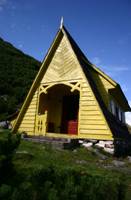
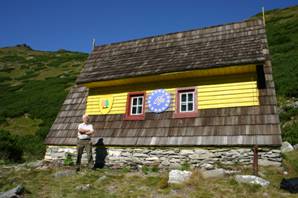

Implementation of the Action C.1 could not take place without this chalet
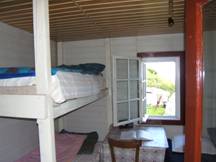
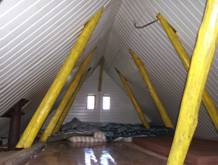
Inside the sleeping room Inside the attic
Action C.3
Information panels, construction and their installation
Expected results:
Ten information panels installed in the project area key points of the main access paths to the Pietrosul Rodnei Biosphere Reserve including project area..
Achieved results
Ten information panels, five in Romanian and five in English, were made of plastic but not metal material as foreseen. This is because the plastic is more resistant to the climatic factors and more esthetic, as well. The panel text written electronically using the Corel Program comprises the European Community recommendations, such as:
the LIFE logo and partners logos placed in front of the panel;
the project objectives;
the project major actions;
a specific recommendation to the public to protect the planted trees and all flora and fauna species from the whole Biosphere Reserve.
the satellite map of the Pietrosul Rodnei Biosphere Reserve was placed on the panel lower side.
With regard to the way the panels were installed, it should be stressed that a Romanian together with an English version of the panel were placed on the same 1 m tall x 1 m wide board, i. e. one version was inserted on the back of the other. In its upper side, each panel was equipped with a roof while in the lower side with two feets
The panels were installed in strategic places accessible and visible to the public, as follows:
the first panel was installed at the entrance in Borsa when come from Baia Mare;
the second was installed in the Borsa Down Town just to the road that starts to the Pietrosul Mountain ;
the third was installed on the tourist road that cross the project area and then climbs to the project chalet and then to the Pietrosul Pick;
the fourth was installed on the tourist path that lies between the Pietrosul Pick and the Inau one;
the fifth was installed just closed to the road on the Prislop Passage from the Suceava to the Maramures County .


The first panel was installed at the entrance in Borsa while the second one on the tourist road that cross the project area and then climbs to the Pietrosul Pick
Action D.1
Implementation of Long-term Conservation Management Plan by integrating the best measures for conservation of all flora and fauna habitats from the Pietrosul Rodnei Biosphere Reserve
Expected results
Implementation the management plan owing to which the flora and fauna habitats / species from the Rodnei Mountains National Park , and the Pietrosul Rodnei Biosphere Reserve including the project area will have better conditions for conservation and development than in the past.
Achieved results
As mentioned at the Action A3, the Management Plan of the Pietrosul Rodnei National Park including Pietrosul Rodnei Biosphere Reserve and the LIFE-Project area was finished and endorsed by the Scientific Committee and by the National Park Committee through an official document registered under the number 43 / June 9, 2006 at the National head headquarter. However, some activities were implemented before finishing the Management Plan, such as public awareness was launched since 2004 year. Installing the 10 information panels containing specific inscriptions regarding objectives and importance of the LIFE-Nature project for the Pietrosul Rodnei Biosphere Reserve was considered as first important action of public awareness. Then, in the framework of the public awareness, information concerning the project actions and results were presented in Power Point in many institutions from Cluj, Brasov , Bucharest , Nasaud, Craiova and Timisoara , Bucharest . Other presentations took place in the project in the frame of the Action E3.
Since the last two years a written guide was written a Ranger Instruction-Guide for the five rangers guard team. This guide foresee details about how the ranger has to act in all possible circumstances in order to prevent any damages to the flora and fauna habitats from the whole Rodnei Mountains National Park which includes the Pietrosul Rodnei Biosphere Reserve and the Pietrosul LIFE area, as well. The staff of the Park, together with the LIFE project team, based on the written Guide, has made a theoretical instruction to the guard team. The access of the tourists and local people to the project area was reduced.
Some other activities included in the management plan have also started since 2004 year, such as:
guarding the whole area mainly during the weekends by the guarding team;
reducing access of the tourists and local people to the important birds nesting areas and to those areas with a higher frequency of carnivores, mainly Ursus arctos, Canis lupus and Marmota marmota ;
the access of the armed people inside National Park was totally and permanently prohibited;
a strong control of the hunters and stray dogs;
inside the National Park, the project area of 50 hectares was established as special protected area;
an agreement with the Borsa local forestry police service was established; it helped very much the guard team in conflicts extinction and in protecting the objectives within the National Park, including project area.
It should be stressed that implementation of the above mentioned actions before the finishing the management plan was recommended by the Scientific Committee of the National Park.
However the total implementation of the Management plan was launched on early January 2007. At present, the Management Plan is implemented in full in order to integrate measures concerning protection and conservation of the flora and fauna habitats from the Rodnei Mountains National Park , including the Pietrosul LIFE area, as well. Owing to the above mentioned measures, flora and fauna habitats / species have better conditions for conservation and development than in the past.
The implementation of the management plan will be continue after project termination.
Action D.2
Monitoring of evolution process of P. cembra species re-introduction and P. cembra / P. mugo / P. abies habitat restoration to the end of the project
Expected results
A draft showing the evolutionary process of P. cembra species re-introduction and of P. cembra / P. mugo / P. abies habitat restoration on 50 ha will be prepared. The obtained scientific information inserted in this draft represents basic data to be included in the final technical report and to serve as a model for reintroduction and restorations of similar habitats in other countries.
A chieved results
To get a higher precision, in 2005 year, 10 (instead of three foreseen) permanent sample-plots were marked across the project area. Each plot with a circle form with 13 m radius was marked at its centre with a red stick to be seen from distance. Within each circular sample an inventory of the seedlings was made in the autumns of 2005 and 2006 years. In each circle there were counted the living and the dead seedlings. At that time the plantation average success (%) per species was very high, such as: 97 % in P. cembra and 95 % in P. mugo and P. abies . On May 27-29, 2007 , after snow melting, a new monitoring process was done by using an improved methodology.
According to the inventory made at the end of May 2007 in the 10 check plots, the following results were obtained:
For cembra pine ( Annex 4, Tab. 1) , the average survival seedlings was as much as 96.3 % but the percent survival varied from plot to plot, i.e. from 93.6 % in plot nine and 100 % in plots number 6, 7, 8 and 10;
For dwarf pine ( Annex 4, Tab. 2 ), the average survival was slightly lower than in cembra pine, i.e. 94.2 % and variation was between 92.3 % in plot number 4 and 100 % in plot one. The rowan planted in the same whole with the dwarf pine has 96 % survival.
In case of spruce ( Annex 4, Tab. 3 ), the average planting success was 92.2 % and the variation was between 90 % in plot number 8 and 100% in some other five plots.
According to the Romanian legislation a minimum of 80 % survival is accepted as good and very good over 90 %.
Based of the above mentioned data, a final report before project termination was compiled. The EC agreed to submit the report and results of this action together with the final report.
Concomitantly with the seedling inventory, observation on behavior or resistance to harsh climate was made, and the conclusions on this subject are, as follows:
as expected, the P. mugo exhibited the highest resistance to the harsh climate conditions from Pietrosul; however, in some sites exposed to the north-west winter winds, not only the planted but also the natural bushes are injured; about 1 % of planted seedlings have suffered;
P. cembra is the next species with high level of hardiness but not so high as the former species; in some north-west wind exposed slopes, about 3 % of seedlings were affected by cool winter wind and some of these seedlings have recovered and some died;
when planted above 1500 m elevation, P. abies exhibited highest susceptibility to the winter cool wind; about 8 % of seedlings were injured and most of them have died.
S. aucuparia , is a not foreseen species in the project, but it was introduced as it is a basic species in the local habitats; it proved to be as resistant as the P. mugo species.
The report showing the evolution process is included in Annexes 1, 2 and 3.


Cembra pine, dwarf pine and rowan seedlings during monitoring
Action E.1
Set up the project website
Expected results
The LIFE project website comprising results obtained in the Pietrosul Rodnei Biosphere Reserve will be available on Internet.
A chieved results
On behalf of the LIFE Project, on January 2005, a website was opened at the following two addresses:
http://www.icassv.ro/life_pietrosu
which is connected to the ICAS website: http:// www.icas.ro
Following your recommendation of February 27, 2007 , the website structure was improved, as follows:
interference and menu of the website is available in both Romanian and English;
a clearer reference to Natura 2000 was inserted.
Everybody can find the project website address inserted in the 4000 disseminated brochures.
The website structure, uploaded deliverable products up to February 2007 and deliverable products to be uploaded during September 2003 are presented in Annex 5.A and 5.B .
Action E.2
Design, print and disseminate informative materials
Expected results
Producing 4 000 printed brochures / about 20 pages / brochure, 2 000 leaflets / 2 page each one and the Layman's report and interactive informative materials for consultations and workshops
Achieved results
There were designated and printed a brochure and a leaflet containing scientific information about re-introduced P. cembra species and restored P. cembra / P. mugo / P. abies habitat. It was demonstrated the way through which this re-introduction and restoration was achieved. The brochure and leaflet contain integrated measures and results with regard to protection and conservation habitats not only woody but herbaceous, bird and carnivore species from the Rodnei Mountains National Park including Pietrosul and LIFE project area. By using the ICAS financial support (printing equipment and materials), 4 000 brochures and 2000 leaflets (in Romanian: PLIANTUL NR. 1 and PLIANTUL NR. 2, 1000 for each) were printed and already disseminated inside the country. These materials, were distributed free of charge in several universities ( Bucharest , Cluj, Brasov , Craiova , Timisoara , Oradea ) high schools (Borsa, Nasaud, Bistrita, Branesti). Forest research institutions ( Bucharest , Brasov , Timisoara , Cluj, Craiova , Mihaesti, Campulung, Bacau , Tulcea, Focsani , Pitesti , C-sebes, Simeria), forest districts (25 units), (Romsilva (headquarter and 23 sub-units), ICAS (95 people),
Academy (seven people), national parks (Muntii Rodnei, Calimani, Retezat, Bucegi, Piatra Craiului, Apuseni, Ceahlau, Putna, Maramuresului), Ministries (Environment, Agriculture), stakeholders, LIFE project beneficiaries and managers, non governmental organizations, and people involved in nature protection were another beneficiary category of these printed materials. However, a certain quantity of them is still available.
All brochures were produced in Romanian. However, it should be stressed that according to the project proposal, 1,000 copies should have been produced in English; because of so many tasks, I was not able to translate in English the brochure and I must apologies for not fulfilling that obligation.
In the frame of the same action, informative materials, including Power Point presentations were compiled and presented in the three workshops.
Samples of brochures and leaflets were delivered to EC on January 2007, together with the Progress Report 3 while the Layman's Report .will sent with the final report.
Compiling the Layman's report
A nine pages Layman's report was produced as a sub-task of this Action E2. This paper provides information about the project purpose, its scope, the way of its implementation and the results obtained using a simple language to be understandable for people that are not specialists in the topic in question. The report is enclosed in the final report as Annex 6.
Because the three kind of informative materials were entirely prepared using the ICAS materials (paper and toner for printing) all these materials were included in the consumable while the manpower was supported by ICAS from an internal project.
Action E.3
Three local workshops and stakeholder consultation meetings
Expected results
Three workshops, followed by an excursion to the project area will be organized.
A chieved results
First workshop and stakeholder consultation meetings
The first local workshop and stakeholder consultation meeting was held o n October 1, 2004 , at the Borsa Town , with the following schedule:
Presentation of the Project solved actions during the 2004 year (I. Blada and A. Filip);
Presentation of the Rodnei Mountains National Park : images and figures (D. Jauca and A. Hadarau).
Stakeholder consultation meeting.
Visiting the 50 hectares planted area with P. cembra and P. abies in the Zanoaga Hollow and Piciorul Mosului from the Pietrosul Rodnei Mountain.
The workshop was attended by 37 persons belonging to: local authorities, local and regional forest administrations, representatives of local economy, and representatives of the Commission of the Nature Monuments, the LIFE representatives, fishermen and hunters.
The first two items were presented on Power Point followed by discussions and questions. Plantation of 50 ha , placed on difficult geographic conditions, was very much appreciated.
After presentation of the first two items, stakeholder consultation meeting took place. Discussions were focused on current problems that are facing not only the project but also the whole National Park. It was welcomed the European Community financial support to the project.
After indoor meeting, in a very sunny afternoon, the younger participants climbed the mountain and visited the planted area where the encountered problems were presented.
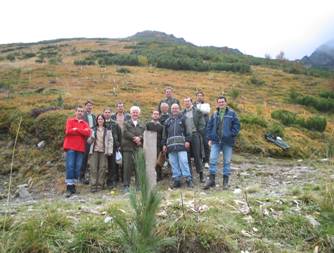
Plantation visit during the first workshop
Second local workshops and stakeholder consultation meeting
The project second workshop and stakeholder consultation meeting took place in the Borsa Town Hall , on October 13, 2005 ,. A total of 38 people, including local and regional authorities, and scientists attended the workshop.
The workshop programme presented in Power Point was:
Scientific inventory of the herbaceous and woody species from the Pietrosul Rodnei Biosphere Reserve (Dr. Gh. Coldea).
Scientific inventory of the bird species from the Pietrosul Rodnei Biosphere Reserve (Dr. Iosif Beres).
Restoration Pinus cembra / P. mugo / Picea abies habitats: plantations with Pinus mugo (I. Blada, I. Muntean, S. Tanasie, A. Dragila and C. Dinu).
A high interest of the participants in supporting the project actions was the main conclusion of that workshop.
The stakeholder consultation meeting took place as the last indoor item where both the officials and scientists discussed and analyzed the present status of the Project. Discussions from the meeting were focused on current problems that are facing not only the project but also the whole Rodnei Mountains National Park . The financial support of the European Community was very much appreciated recognizing its contribution to the restoration of the habitats from the Pietrosul Rodnei Mountain . It was appreciated that the habitats restoration by planting according to the Project objectives is going on very well as 67 % of the of the objective was accomplished after two working seasons, only.
After the indoor meeting, the youngest participants have climbed the Pietrosul Mountain and visited the 2005 and 2004 plantations from the Project area. It was recognized that the plantations with the three species look very well even though a lot of difficulties were encountered during the seedlings transportation and plantation at high elevation.
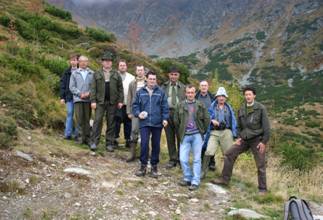
During the second workshop, only 12 participants have climbed
to see the planted area
Third local workshops and stakeholder consultation meeting
As foreseen in Milestones table, this workshop took place in Borsa, on May 30, 2007 . The workshop schedule was, as follows:
in Power Point presentation of the project tasks and outcomes;
presentation of the first and the second film;
questions and discussions;
stakeholders consultation.
As can be seen from the above schedule, at this last workshop all project tasks and the outcomes were presented in power point and discussed. The participants to the workshop and to the stakeholder's consultation have appreciated the invested effort in solving the major project task. The final conclusion was that all actions except D2, E2 and F1 were fulfilled in good conditions.
Public awareness
In order to inform the people about the project implementation, several public awareness actions were developed, such as:
installing 10 information panels in the Borsa / Pietrosul area containing specific inscriptions regarding the objectives and importance of the LIFE-Nature project for the Pietrosul Rodnei Biosphere Reserve (Action C3);
written materials like 4000 brochures and 2000 leaflets were distributed to a large number of people and institutions (Action E2);
a Layman's report was produced in order to provide information about the project objectives, the way of its implementation and the obtained results using a simple language to be understandable for people that are not specialists in the topic in question (Action E2).
audio-visual presentations in media, including two video films took place (E4);
the project plantation was two times (August 12 and 13, 2007) presented at the National TV by the Romanian Realitatea Channel ;
the project results presentation in Power Point in many public institutions, like schools, universities, research units, forest districts and in an international conference..
Based on in Power Point presentations, the audience was informed about the project results.

Project results were presented at the Nasaud High School of Silviculture
( November 22, 2005 )
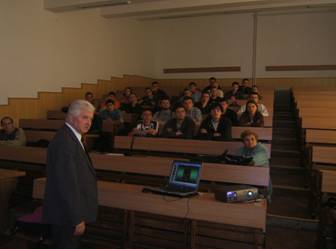
t the Brasov Faculty of Silviculture
Between September 19-23, 2007, the LIFE project manager has organized Valiug, Romania, an international IUFRO Conference in five needle pines, including Pinus cembra where 37 scientists from 11 countries attended. A Power Point presentation about the Pietrosul LIFE-Nature project and the first film were presented during this Conference. As specialists in pines, the attendees highlighted the importance of Pinus cembra reintroduction and Restoration of Pinus cembra / P. mugo / Picea abies habitats from Pietrosul
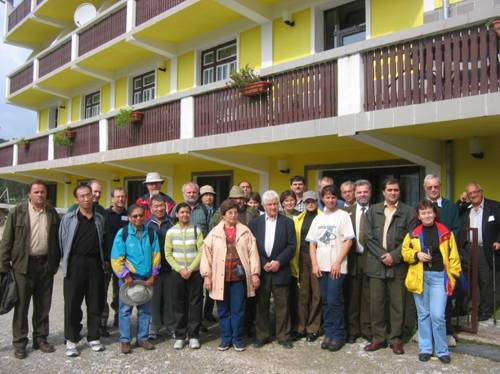
Some participants to the IUFRO International Conference to whom the project results
including the first film were presented
Action E.4
Video documentary films and media presentations
Expected results
Two documentary films and other informative materials will be produced for project meetings, for other national and international meetings and for public awareness. Also, the films will be used for public awareness regarding the LIFE project actions and the acquired results.
A chieved results
First video documentary film ( Title: Refacerea habitatelor or Habitats restoration )
Images for the first film were collected during the year 2005 and film was finished on early January 2005. The intention was to show how the plantation and its associated actions are going on in difficult mountainous conditions. Seeing the film sequences, one can see how danger was the seedling transport, on a primitive bad road, from Borsa to Pietrosul at about 1700 m elevation. Heavy action connecting with caring sticks and seedlings on the worker back over the very sloppy planting area, digging or hoeing seedling beds and plantation in a stony and sloppy land were also caught in the film. The film duration is about 25 minutes.
According to the Standard Provisions recommendation, the LIFE logo and the recognition Community financial contribution was clearly inserted in the film.
Second video documentary film ( Title: Date despre vegetatia din Pietrosul or Data about vegetation from Pietrosul Rodnei )
This film presents details about flora from the Pietrosul and its surroundings. Images were collected during the vegetation season of the year 2006 and the film was ready just before the end of the 2006 year. The duration of the film is about 50 minutes
The two documentary films were displayed in the third project workshop, and then . The film will be presented in national and international meetings on nature habitats restoration and conservation.
In order to disseminate the LIFE project results, DVD copies of the two films, partially were and the rest will be distributed to different organizations and personalities involved in nature protection, universities and forestry high schools.
The address where the two film masters are deposited at the following film Company:
Company: Albu Mihai Liviu Asociatie Familiara
Adress: Str. Stavilarului No. 6, Borsa, Judetul Maramures , Romania
E-mail: studio_aml@yahoo.com
Both films were delivered to the EC together with the third progress Report.
Upon request, the films can be ordered to the ICAS <icas@icas.ro> or to the project manager <ioan_blada@ yahoo.com>. The price will be calculated later one by the ICAS accountancy department.
Both films were uploaded on the project website and sent to EC with the Report 2, the firs film .and with the Report 3, the second one.
Durable goods procurement in frame of the Action E.4
A Sony video camera was purchased. It proved to very useful to collect images for films and other aspects connected to the project.
T he video camera is included in the ICAS inventory but it will be used by the project manager or / and his successor for fuming the project habitats evolution and plantation success and for other actions from The after LIFE-Conservation Plan (Annex 2)
Action F.1
Project management and monitoring
Expected results
Preparation of three annual technical reports, a final technical, three annual financial reports and two independent audit reports.
A chieved results
During the project life, the following reports were prepared and sent both to the European Commission and to the External Monitoring Team, such as:
Technical reports
Technical progress report 2004
Technical interim report 2005
Technical interim report 2006
Financial reports
Financial progress report 2004
Financial interim report 2005
Financial interim report 2006
Audit reports
Audit interim financial report 2005
The audit report was paid from other costs but it was erroneously foreseen to personnel.
Action F.2
Workstation Development
Expected results
Three PC, two printers, a laptop, a slide and a overhead projectors will be purchased.
A chieved results
In the frame of this action, the following durable goods were purchased: two desktops PC, a laptop, and a printer. The laptop was purchased instead of a desktop. This laptop helps the working team in many occasions but mainly when outside the Institute. The three computers proved to be very useful for office everyday activities and project database establishment. The flipchart and slide and overheads projectors were not purchased because they are not in use now.
These durable goods, already included in the Institute inventory, will be used by the ICAS LIFE team that was directly involved in the project implementation, as follows:
the laptop will be used by the project manager or / and his successor in the frame of the forest genetics laboratory;
one desktop PC will be used by Mrs. Cristiana Dinu, principal technician from forest genetics laboratory who works permanently in ICAS;
one desktop PC and the printer will be used by the principal technicians Mr. Stefan Tanasie and Mr. Andrei Dragila who works at the ICAS Forest Research Station located in Caransebes.
All the above mentioned durable goods were included in the ICAS inventory.
All project deliverables are presented in the Annexes 7 A and 7 B.
7. EVALUATION AND CONCLUSIONS
Project implementation
a, The process
The process of project implementation has followed all technical details presented in the Preparation of technical management plan aiming at P. cembra species re-introduction and P. cembra / P. mugo / P. abies habitat restoration (Action A.2). In addition, specific details concerning project implementation were inserted at each solved action.
b. The project management
Project implementation encountered many and serious problems and these are presented below, in brief.
the seedlings transportation from about 500 m elevation at Borsa to about 1750 m at Pietrosul was one of the major problem because, the sloppy, stony and primitive road, and lack of a suitable vehicle; the caterpillar tractor has turn over and the driver was close to dying;
sloppy and stony of project area that created difficulties for sticks and seedlings in plastic pots carrying on the worker back;
difficulties encountered in seedling beds preparation because of many stones present in the soil;
whether conditions, like heavy rains, and winds that occurred during the field work;
During the Action C1 and C2 implementation, the working team benefited of the FSAM / Baia Mare, Borsa Forest District and the RMNP partnership.
c. Success and failures
The initial foreseen technical methodology stipulated in the Application Forms and mainly in the actions A1, C1, C2 and D2 was a successfully one in term of obtained results and cost efficiency of actions.
d. Comparison against the project-objectives
All the objectives were met; most of them in good or very good conditions but some of them like the first video film in unsatisfactory qualitative conditions. The project manager's lack of knowledge in this domain is responsible for that semi-success. But definitely, the two major actions were the most successfully ones. These actions are, as follows:
Action C1 Effective re-introduction of P. cembra and restoration P. cembra / P.mugo / P. abies habitat by planting on 50 ha ;
Action D1 Implementation of Long-term Conservation Management Plan by integrating the best measures for conservation of all flora and fauna habitats from the Pietrosul Rodnei Biosphere Reserve and finally from the whole National Park.
e. Environmental benefits, policy and legislation
Even from now the environmental benefit was evident and it was noticed in the last three winters because no avalanches occurred on the steepest slope of the project area. This happened because, not the seedlings but the 12350 seedling beds together with their 12350 1 m tall sticks have worked against avalanche initiation. But in the future when the seedlings will get taller, they effectively could prevent not only soil erosion but the avalanche, as well.
Because there is a strong guard team that cooperates with the Borsa mountain gendarmerie, the conservation benefit is already very high. They supervise and control all negative actions of the tourists and illegally hunting across the whole National Park. The grazing and cutting trees were completely stomped and consequently, the flora and fauna is recovering where it was damaged.
The management plan incorporate all essential legislation aiming at natural habitat protection and conservation.
f. Innovation, demonstration value
Perhaps it would be too much to call innovation any of the methods used for project implementation but definitely some procedures can be call as originals and they worth to be highlighted, such as:
for example in Switzerland, namely in the Davos mountainous zone, for transporting potted seedlings from down to uppermost planting site, they use helicopter or cable railway but the caterpillar was used in Pietrosul; this is original and suitable for poor people;
preparing the seedling beds in the spring save a lot of currency because the weeds' stems were destroyed during the winter frost and snow and the roots are very weak; in such conditions the worker's work is much easier comparing with autumn preparation; in addition, during the summer time, the seedling bed soil accumulate moisture and makes the plantation easier during the autumn, and this means less currency for the manpower, like in this LIFE project; this procedure is original; one may compare our small project requested amount (to solve difficult actions) with the amounts requested by other Romanian LIFE projects;
in Pietrosul, two seedlings, i. e. P. mugo and Sorbus aucuparia were planted in the same hole; this original procedure save currency for plantation and in addition such plantation better stabilize the soil, prevent soil erosion and flooding in downstream, will be more efficient against avalanches and finally by this way is easier to restore the natural habitat;
producing P. cembra seedlings without seed stratification represent another original method and because this procedure save a lot of currency, it could be called a small innovation.
The above mentioned original procedure could potentially be applied in other protected or non protected areas or in other member states. Our team is open to cooperate for the nature benefit.
g. The future sustainability and project continuation,
Any project beneficiary should not consider the project finished immediately after project termination otherwise the whole invested effort could be lost. Concerning this LIFE project, at least four members of the team will take care of the Pietrosul plantation. The Annex 2 foresee several action to be taken up to 2010 year, and perhaps onwards, by the ICAS and FSAM; four members of the team (we know who are they) will be directly involved in this matter.
i. Long term indicators of the project success
Yearly, the project (remainder) team will solve the foreseen actions in the Annex 2. Special attention will be paid to the stipulated actions 3, 4 and 5. The few missing seedlings will be replace on September, this year together with the survival seedlings inventory in the 10 check plots. Their health state according to the scale, already established, will also recorded. These data help to evaluate the evolution process of the plantation. Together with the guarding team of the MRNP a special attention will be paid to the species / habitats protection across the whole National Park.
9.COMMENTS ON FINANCIAL REPORT
A comment on budget items will be made at beginning and then a general overview is presented.
Specific comments to the financial report
Personnel
In the Provisional information on personnel (Form 2003-31) the project manager was overestimated (7140 hours) while the technicians vice-versa (1360 hours), but finally compensation between the two categories re took place.
In the revised project budget, 37720 € out of 107655 € were moved from personnel to the external assistance.
In case of the personnel item, discordance between ways of salary calculation was noticed such as (Annex 8, Table 4 , last two columns).
(a) using a direct calculation based on time sheets, the ICAS has obtained a total of 69041 € for personnel ;
(b) According to the EC standard programme calculation based on the same time sheets, a total of 71410 € Euros for personnel item was obtained, i.e. a difference of 2369 Euros. As the beneficiary has used this latter variant, is up to the European Commission to decide which one should be taken into account.
Finally the personnel was exceeded by 1475 € but compensation from external assistance took place.
Travel
In the revised project budget, 300 € out of 8300 € were moved from travel to external assistance
Mr. Stetca Ioan, a past member of the project, attended to the seedling beds preparation (C1). Because he really has attended that action, his travel was charge to the project but not his salary. This is because it was paid from another project where the project manager was responsible. To save the LIFE project currency was the reason why he was paid from other project. After 2004 year, because of its weak work efficiency he was removed from the project team.
At the end of September 2004, the project manager has attend the Workshop on mountain forests that protect against rock fall and avalanches held in Vaujany / Grenoble where the following presentation took place: Pinus cembra provenance test and its connection with avalanche preventing. This participation was approved by Mr. Philip Owen (letter from 12.07. 2005). According to the recommendation, a copy of the paper and in Power Point presentation was sent to the Commission and uploaded on the project website..
External assistance
Initially, no currency was foreseen to the external assistance but according to the approved revised project budget (No. 16882/31.08.2005) an amount of 52297 € from personnel and from consumable was moved to this item.
the currency to be paid for the independent audit was foreseen in the approved revised project budget but finally the audit payment was done from the other costs.
Consumable
According to the approved revised project budget (No. 16882 / 31.08.2005) out of 58800 € from consumable, an amount of 5500 € was reduced in favor of external assistance. The remained amount was as much as 53300 € but this limit was exceeded with 10001 € which was taken from external assistance. This surpass consisted in charging materials necessary for seedlings, brochures, leaflets, Layman's Report and some other consumable of small value.
A specific mention has to be made in connection with the price of the seedlings that were produced by ICAS and used for plantation in the project area. The price calculation was based on very detailed costs estimation according to the Romsilva National Company normative guidelines. The external auditor has found that the ICAS has correctly used the cost price which did not include the benefit. It is stressed that the benefit was included in the sale price and such price is practiced only when the seedlings are sold for commercial reasons, but not in this co-financing case. A listing with the basically calculation of the price will be enclosed to our audit report. It is regrettable that during the project visit in Borsa (30 of May 1 June, 2007 ) by the EC delegation I have not noted that the benefit was included in the sale price but not in the cost price . Mr. Halada who recently visited the project documents was informed about this situation. In conclusion the ICAS has charged the seedlings cost with the cost price which do not include the benefit. The year to year analytical calculation of the seedlings cost is presented in the Annex 9.
Action E.2 Design, print and disseminate informative materials
According to the Revised Project Budget approved on August 31, 2005 / 16882, the 4000 brochures and 2000 leaflets and 1000 Laymen's Report, the printing was foreseen to be made by a printing company by paying an amount of 5000 Euros. But, it was not possible to find a company to print these materials only with that amount. For that reason, it was decided to produce them in our Institute at a much lower price because the manpower was charged to other ICAS project while the LIFE project was charged only with paper (197.3 €) and toner for printing (703.5 €). Details concerning cost estimation are giving, as follows:
Necessary colored toner for printing: 703.5 € (549.47+154.05 € taken from Consumable Standard Form)
Necessary paper and its cost
Brochures: 4000 x 6 sheets = 24000 sheets;
Leaflets: 2000 x 1 sheets = 2000 sheets;
Layman's Report: 1000 x 6 = 6000 sheets
Total paper 32000 sheets = 68 reams of paper
Total paper cost = 197.73 €
(See 95.80+59.35+29.68+12.90 € taken from Consumable Standard Form, years 2006 and 2007).
Total cost 703.5 + 197.73 = 901.26 €
Please approve to charge to consumable the entire cost of the paper and the toner for printing . The standard form of the consumable contains the abov mentioned toner for printing and paper.
Other costs
A total of 1000 € was initially allocated but there was spent an amount of 3060 € , i.e. 2060 € more. This item has mainly supported the interim and the final independent audit report of 1500 € and 1560 €, respectively. Because they were erroneously foreseen with the External Assistance, both of them were supported from other costs .
Overheads
According to the revised project budget, the allocated amount was as much as 9548 € and the item was charged with 9893 €.
The ICAS did not charged the overheads for the delivered seedling to the project. This is normal because the overheads have included in the cost price and it is not correct to charge them once again to the project.
The ROMPETROL and LUKOIL are the ICAS suppliers with gas oil for heating and they require the payment before delivering their product.
6% of overheads were foreseen in the Application forms , but finally 7% were charged.
Interest accrued on the amounts received from EC
An amount of 371.22 € was received as interest from the BCR Bank, the Voluntary Branch f
Tab. The interest accrued between January 1, 2004 and May 31, 2007
Period |
Interest* |
01.01.2004-30.06.2005 |
180.54 |
01.07.2005-11.12.2005 |
30.00 |
12.12.2005-31.12.2006 |
104.42 |
01.01.2007-31.05.2007 |
56.26 |
Total |
371.22 |
*According to the interest sheet issued on 24.08.2007
by the BCR Bank, the Voluntari Branch
General comments to the financial report
The project start was foreseen on June 1, 2003 but the approval was issued on October 13, 2003 . Action C2 refugee chalet and toilet construction were the major works to be fulfilled in Pietrosul in that year. At that time when the approval arrived, in Pietrosul was snowing so that, the Action C2 could not be fulfilled, and the decision to start the project on January 1, 2004 was taken. Please accept January 1, 2004 as date of project starting and for calculating the depreciation.
A request of revision project budget was approved by the EC on August 31, 2005 under the No. 16882. A summary of the initially allocated budget on items and approved in the Revised Project Budget is given in Annex 8, Table 2. The main request was to approve part of the currency from the personnel and from some other item, to be moved to the external assistance for the reasons explained in detail in the respective request. The initial project amount remained the same, i.e. 213470 €.
All project costs were converted to Euro using the exchange rate applied by the European Central Bank on the first day of month in which the payments took place. This is because each financial document immediately after payment was introduced to bookkeeping. The project manager is responsible (for this mistake) for not asking for approval to the EC as SAP recommends. Honestly, I did not read attentively the whole sentence of the art. 25.4. On August 17, 2007 it was Mr. Halada who attracted me attention about that mistake. Please approve to use the monthly exchange rate which was operated in our whole accountancy. It should be stressed that at start (January 2004) the rate was 4.1122 and at the last project day ( June 1, 2007 ), it was 3.2646, i. e. a difference of 20.6%. The financial final report was prepared using monthly exchange rate.
The total allocated amount to the project was as much as 213.470 € and the funding and the budget breakdown are presented in the Annex 8, Table 1 which shows the contribution of each participant to the project.
The budget allocated and spent currency by items and credit balance are presented in the Annex 8, Table 3 , with the following details:
- the entire project allocation (231470 €) was spent;
- In some items the foreseen amount was exceeded while in some others the spent amount was lower than the foreseen one;
- Exceeding the foreseen amount in personnel, consumable and overheads is in line with the SAP.
- The other costs item was exceeded by 2060 € and because the approval was not requested in advance, this payment is not in line with the SAP.
The effective financial contributions to the project of each partner are listed in the Annex 8, Table 4 , with the following remarks:
- out of 213.470 Euros, an amount of 213.467 Euro was spent for project implementation that took place between 01.01.2004 - 01.06.2007;
- the EC, ICAS and FSAM contributed with 35%, 45% and 20%, respectively; in other words, the ICAS spent more than foreseen while the others, less;
- it should be remembered that out of 32020.50 € (our second payment), an amount of 21289.59 € was taken by the EC to cover the failure of the LIFE02/RO/8571 project; this loss was covered by the ICAS.
The Annex 8, Table 5 ( last two columns) presents in details the s tructure of expenses on budget items, years and participants to the project;
- In case of the personnel item, there is discordance between ways of salary calculation, such as:
(a) using direct calculation based on time sheets, the ICAS has obtained a total 69041 € for personnel ;
(b) According to the EC standard programme calculation based on the same time sheets a total of 71410 € f or personnel item was obtained, i.e. a difference of 2369 € . As the beneficiary has used this latter variant, is up to the European Commission to decide which one should be followed.
10. Conclusions
All actions foreseen for project period were solved.
The effective re-introduction by planting of P. cembra species and restoration of P. cembra / P. mugo / p. abies habitat on 50 hectares was successfully accomplished. With regard to this Action C.1, the following details are given:
initially, 10 000 seedlings (2 500 Pinus cembra , 2 500 Picea abies and
5 000 Pinus mugo were planned to be planted on 50 ha ;
finally, 15 550 seedlings were planted on the same area, so that an amount of 5 550 in addition; the in addition seedlings were, such as: 2 350 Pinus cembra and
3 200 Sorbus aucuparia ; though this latter species was not included in the Application Forms, it was planted for three reasons because (i) it has been a natural component of the Pietrosul habitats, (ii) it is a very fast growing at its young age, and due to its fast growing, within three to four years after planting it starts to play a significant role in preventing avalanche initiation.
The long-term conservation management plan by integrating the best measures for protection and conservation of all flora and fauna habitats from the Rodnei Mountains National Park ( 46399 ha ), including the LIFE Pietrosul area was successfully implemented.
By making inventories of trees, herbaceous, birds, mammals, fishes, amphibians and reptiles species, the project contributes significantly to the science.
Based on satellite imagery, the habitats map of the Pietrosul Rodnei Biosphere Reserve was obtained, and this represents a premiere for the northern Carpathians.
The acquired results via this LIFE project, were and still will be largely disseminated in the frame of the public awareness, such as: a lot of Power Point presentations, TV, brochures, leaflets, video documentary films, panels, project website.
During the project meetings, workshops or video presentation, the local authorities, stakeholders, scientists, foresters, teachers, students greatly appreciated restoration of the Pietrosul habitat.
The cooperation with the county and with the REGFOR Company that executed the field works was remarkable; otherwise the planting could not take place.
Finally , the project author and manager express his gratitude:
to the REGFOR company and its hard working workers that fulfilled all physical works for the Pietrosul habitat restoration in very good conditions;
to the Forest Administration of the Maramures County and to the Borsa Forest District for their co-financial support; their currency was used in operations connected to the seedlings transport, field marking, seedling beds preparation, seedlings distribution on the field, plantation and for the nice and useful chalet construction;
to the Forest Research and Management Institute for its co-financial contribution; it contributed high quality and expensive seedlings (including those supplied free of charge), technical personnel involved in the project implementation, offices for technical personnel, manpower for printing and disseminating the informative materials, supporting 21289 € that represent failure of the other LIFE project implemented in Romania;
to the External Monitoring Team for its helpful guidance and advice both in the field and in the office on how to solve some actions;
to the European Commission for its 50% financial contribution to project implementation ; its currency was mainly used for the personnel salaries and for the durable goods; the entire this help was offered in a moment when the ICAS is passing a difficult economical situation.

